
Free Site Analysis Checklist
Every design project begins with site analysis … start it with confidence for free!

How to Create a Successful Architecture Presentation Board
- Updated: December 31, 2023
Architecture is as much about effective communication as it is about innovative design. At the heart of this communicative process lies the architecture presentation board, a tool quintessential for architects to convey their vision, ideas, and concepts.
These boards are more than mere visual aids; they are the narrative bridge between an architect’s imaginative conception and the practical world where these ideas may take shape. They are not just a requirement for academic submissions or professional proposals but are a fundamental aspect of the architectural design process.
They serve as a canvas where ideas are visualized, concepts are explained, and designs are brought to life for various audiences, be it clients, peers, competition judges, or the general public.
Understanding how to effectively create and present these boards is crucial, as a well-crafted presentation not only showcases a finished scheme but also reflects the thought process, attention to detail, and the authors ability to communicate complex ideas succinctly and visually.
What are architecture presentation boards used for?
Architecture presentation boards serve several different purposes:
- Students use them to present work to their professors and peers.
- Professionals use them to present designs to clients, committees, shareholders, and exhibitions.
- They may be a means to win a commission, or they may help to take a project into the next stage.
What is the purpose of an architecture presentation board?
Architecture presentation boards are a tool to showcase your work. They are a way to draw your viewers into your design process and methods, providing an overall summary and vision for the project. You are communicating your design and showcasing your artistic skills, and your sense as a designer.
Every successful project has a central concept, a “big picture” theme that gives it purpose. When you look at your project, what is that big idea?
As it is central to your whole project, this will guide you as you prioritize your work and determine the flow of your ideas. The primary purpose of your project is to communicate this central concept in the best way possible.

AutoCAD Template Kit
Format your drawings with the correct set of tools. This CAD template enables you as a designer to spend your time on what matters – the design!

Stop searching for CAD blocks!
How do you layout an architecture presentation board, 01 – structure/order.
Before you begin laying out your presentation board, think about the main points you want to convey. From there, determine what images and graphics will best represent those ideas. Gather all of the information you will need, making a note of what graphics and text you will need to communicate your ideas.
Remember, you are essentially telling a story, so pay close attention to the flow of the narrative as you arrange your elements. Consider the beginning, middle, and end of the story you want to tell.
Depending on the guidelines you are given, you may present your boards side-by-side, as separate boards presented in a sequence, or as one big poster. If no strict parameters are in place, figure out what structure and layout will tell your story the best. While a series of boards will logically convey your story, one big board is often the easiest option.

02 – Orientation
Will your presentation board be oriented in portrait or landscape? Sometimes you will get to make that call, but many times it will be determined for you by your director, client, or professor. Make sure you know beforehand what the parameters are.
If you get to choose, give it some careful thought. Which orientation will give your graphics the room they need to be the most impactful? Which orientation gives your whole project a natural flow for your narrative?
03 – Size
Much like orientation, you may or may not get to decide what size your presentation boards will be. You will often have restrictions that limit you to a specific board size and a certain number of boards.
Make sure you know your limitations before you start working on your layout. Your boards should all be the same size to achieve continuity.
You can use a combination of different sizes to produce a board of equivalent size. For example, a combination of two A1 boards will add up to an A0 board.

04 – Layout
The most common way to organize your layout is by using a grid. Using a grid will help keep the boards in your project consistent.
If you are using InDesign , you can achieve this uniformity by creating a master page that acts as a template for your whole project.
Templates are useful because they can save you a great deal of time, and they ensure uniformity throughout your project. Your grid should include spaces for titles, numbering, your name, and any other information that will repeat on each board.
Before you start laying out your actual boards, sketch out various configurations so you can determine what will work best. You can do a small-scale sketch to get the basic idea of the flow of each board. This allows you to change the arrangement of the elements before you commit to anything on your boards.
You can do this initial phase using software or sketching it out on paper.
After you have determined what type of layout you want to use, estimate how much space you will need for each element on the page. Each graphic needs to be large enough to have an impact. Determine how much space you would like to leave in between each graphic.
Use equal spacing throughout your project to create continuity. Here is an excellent tutorial on planning your layout using Indesign:
The layout of each board should show the relationship between all of the elements. It should be clear to read and follow a logical left-to-right and top-to-bottom progression.
Imagine a viewer looking at your presentation. What do you want them to see first? What is the best way to make them understand your project? Does your layout achieve this?
You should also pay attention to the relationship between each board. Is there a logical progression from one board to the next? Does the sequence make sense? If you will not display the boards in a configuration that makes them all visible at once, make sure you number them, so your viewers follow the correct sequence.
Don’t feel the need to fill every square inch of your presentation board. Leave enough space so that it doesn’t look too busy or cluttered. On the other hand, don’t leave too much space either, or it will look like you didn’t finish the board, didn’t have enough material for the board, or that you didn’t work very hard.
05 – Visual Hierarchy
Some of your images need to garner more attention than others. Consider all of the graphics and text you will be using. Which images are central to your main idea?
The images that are essential for communicating your vision should take up more space in the grid. You should have an image that people can see from a distance and other images that they can see from up close. This creates a visual hierarchy.
What is the most important aspect of your project? Make that the element people can see from a distance. There are ways to accomplish this in addition to making it the largest element on the board. For example, you can use color to draw the viewer’s eye to a particular graphic, especially if the rest of the board is monochromatic.

06 – Background
The background of your presentation board should be simple. This allows the viewer to see all of the elements without the distraction of a busy background. You don’t want anything to detract from the critical details of the board. Your graphics and text should be the primary focus; don’t use bold colors or textures that will detract from that.
A white, or even light gray, background will make your graphics and text stand out. It will give your presentation a professional look that isn’t too busy. You can use other colors if they help convey your central concept; just make sure the background is plain enough that the viewer focuses on the design, not the background.
Be very selective when using a black background, as it may make the text harder to read, and your graphics may not stand out as much as you would like them to.
Whatever color you choose for your background, use it to your advantage. Effective use of negative space can make your design look clean and professional.

07 – Color Scheme
Many professionals and students stick with black, white, and gray for presentation boards. While this can give your boards a professional look, don’t be afraid to add a pop of color. While sticking with greyscale may seem like a safe choice, there is a risk of blacks and greys making your design seem cold and lifeless.
Think about ways you can use color to bring life to your design. You may opt to add just one color, such as green for landscaping, to provide contrast to an otherwise monochromatic presentation. You could also bring in an additional color to represent a particular building material (brick, glass, wood, etc.).
You can also choose a brighter, more eye-catching color, such as yellow or orange, as a feature in your diagrams . Whatever you choose, use the same color across all of your boards to maintain a consistent flow.
If color is one of the main focuses of your project, or if there are details that you cannot adequately represent in greyscale, then you should feel free to delve deeper into the world of color. Don’t limit yourself to merely an accent color in this case, but don’t take it too far and make the mistake of overusing color to the point where it is a distraction.
08 – Font
All of the text throughout your project should be in one font. Don’t use font style as an avenue for creativity; it is more important to make sure the font style and size produce a readable, consistent product.
Sans serif fonts, such as Helvetica or Futura, will give your presentation a clean, minimalist look.
Avoid script or handwriting fonts, as they will not give your boards a clean, professional look. Keep the color of your font dark (black or dark grey work well) to provide contrast to a light background.
Whichever font you select, make sure the style and size are readable for your viewers before you finalize your boards. The best way to do this is to print out your text on an A3 paper, pin it up somewhere, and stand back to see how it will look when it is displayed.

A full breakdown, list, and description of the most popular fonts for architecture can be found here .
09 – Title
The most common placement for a title bar is the top left since your board will most likely follow a left-to-right and top-to-bottom progression. Many successful and professional-looking boards have titles at the top right, at the bottom, or somewhere in the middle.
Choose the position that makes the most sense for your project. As with other design decisions, make sure it does not distract the viewer from seeing the big picture.
Make sure the title placement is consistent from board to board. This consistency will be both visually appealing and professional.
10 – Text
Keep your explanations concise. People are not going to spend much time reading lengthy descriptions, so only include relevant information and keep it short. Remember that your text boxes are part of your visual hierarchy, so utilize the size and alignment to complement your graphics. Consider the various ways you can align the text within the text box. What flows best? What is pleasing to the eye?
Aside from your title, do not use all capitals in your text. Your work will look more professional and be easier to read if you stick with the standard rules of capitalization.
Whenever possible, use a graphic or a sketch, rather than an explanation, to portray an idea. Since this is a graphic presentation, you want your graphics to tell the story, not your text. Include a concise statement that highlights the features of your design. This is basically your sales pitch; lengthy explanations will make you lose your audience.
11 – Image Selection
The selection of images is a critical part of putting your presentation board together. The graphics you choose can make or break your entire design presentation.
You want to select the images that best convey the important details of your project. If you use too many images, your presentation may appear cluttered and confusing. If you use too few images, it may look like you did not put much effort into your presentation.
Over the course of your project, you have generated countless sketches, renderings, models, and drawings. Resist the temptation to include everything just to show how hard you worked. Keep your big picture in mind and determine which images will directly show or best support that idea.

12 – Models
On occasion, a physical model, or even several models showing different aspects of your design, may be required for your presentation board. This is an additional means of communicating your vision to your viewers.
There are several materials you can choose for your model. Card and cardboard are inexpensive and come in various weights, finishes, and colors.
Foam board is also available in various widths and thicknesses. It is generally white, but it also comes in other colors. It is very lightweight and sturdy, making it an ideal material for your presentation board.
Balsawood is another good option. It is easy to work with and comes in varying weights. The material you choose will depend on the look you are trying to achieve as well as how much weight you can adhere to your presentation board.
Your model pieces can be cut by hand with tools such as an X-Acto knife or a scalpel. If you have access to a laser cutter, it will save you some time and give you more precision.

13 – Time Constraints
Give yourself enough time to produce a well-thought-out, effective, visually appealing presentation. You spent a considerable amount of time on your design; it would be a shame to rush through your presentation boards. Give each part of the process enough attention so that your final product really showcases and highlights your talent and hard work.
Time management is critical when working on a big project like this. It can seem overwhelming at first, so split the project into smaller sub-tasks to make it more manageable. Give yourself a deadline for each of those smaller tasks. Make a schedule that shows which tasks you will accomplish each day. Make sure you leave yourself a little wiggle room in case anything unexpected comes up.
What should be included in an architecture presentation board?
Unless you receive explicit instructions regarding what to include in your presentation boards, it is up to you which elements make the cut. When you are deciding what elements to incorporate into your project, reflect on what will best explain your design.
When someone completely unfamiliar with your project is looking at your boards, what do you want them to see?
When deciding what text to include in your project, make sure you include an introduction, your design brief, and any applicable precedents. In addition, you will want to include concise textual explanations as needed throughout your presentation.
For your graphic representations, you want to include the basics: elevations, floor plans, and sections. You can represent these with 3d drawings, perspectives, or renders. You may also include some key features of your design that make it unique, and in addition to highlighting the finished product, select elements that show your concept and design development.
Some additional tips:
- When choosing a perspective view, select one that highlights the best aspects of your design. This graphic is usually the most prominent picture on the presentation board. The hero image!
- You will want to include at least two different elevation views so your viewers can get a sense of the bigger picture.
- Don’t be afraid to include sketches. If you include some sketches that show the progression from a simple idea to the final product, you can communicate your vision as well as your process.
When you are adding all of these elements to your presentation board, make sure each graphic representation of the plan has the same orientation. If one picture has north pointed in one direction and another picture has north pointed in a different direction, it can be disorienting for the viewer.
Likewise, each graphic should use the same scale unless there is one picture that is bigger than the others for the purpose of visual hierarchy.
There is one obvious detail that you may inadvertently overlook. Make sure your name is on your presentation board. If you have more than one board, put your name on each one. The name is in the bottom right-hand corner, but it can also appear in the title bar.

Types of Architectural Presentation Boards
Organizing your architectural presentation sheets into specific categories can be a very effective way to present your projects. There are several types of architectural presentation boards, and the following tips can help you present your project at different stages:
C onceptual board
Concept sheets are a type of presentation board that showcase your initial ideas and approach to a project. They typically include information about the concept behind the project and how design decisions were made. It is important to submit concept sheets before presenting your architectural drawings and renderings.
When creating concept sheets, you may want to include conceptual collages and diagrams to help explain your ideas to the audience. These can be created using 3D modeling software or programs like Adobe Photoshop or Illustrator. The goal of concept sheets is to clearly and simply present the various stages of your project to the review panel.
Site a nalysis board
Before beginning a project, architects perform thorough analyses to determine the needs, conditions, and limitations of the site. This analysis serves as the foundation for the concept development. Site analysis boards may include site analysis, urban scale analysis, sociocultural analysis, analysis of physical conditions, and environmental analysis.
It is important to conduct extensive research and present your findings in a clear and organized way, as analysis boards can help reinforce the concepts presented in your architectural drawings.
It is also important to keep in mind that the jury members may have difficulty understanding analysis presented alongside the architectural drawings.
Technical / Detail Board
Technical drawings are a crucial aspect of architectural projects, as they help to depict the structural elements of a design and guide the construction process. It is important to present technical drawings in a clear and organized manner, particularly in application projects and student projects.
Technical drawing boards should typically include a master plan at a scale of 1/5000 or 1/1000, as well as site plans and floor plans at a scale of 1/500, and sections and elevations at a scale of 1/200. Detail drawings, including system sections and details at scales of 1/20, 1/10, and 1/5, should also be included on the technical drawing boards.
These drawings will help to provide a more complete understanding of the project to the review panel.

Professional Boards
While student projects and competition entries are evaluated by a panel of judges, in professional practice, the client serves as the “jury” for your work. Instead of preparing presentation boards in the same way you would for school or competition projects, it is important to create presentations that will appeal to clients.
The most important factor for most clients is the design of the living space, so it can be helpful to focus on renderings and plain plans rather than technical drawings. The visual appeal of your presentation boards, including the color scheme and atmosphere in the renderings, as well as your ability to effectively present and explain your ideas to the client, will also be important factors in their evaluation of your work.
Programs, Software, and Tools
There are several software applications you can use to build your presentation board. Choose one that you are already familiar with, so you aren’t trying to learn new software while you are doing your layout. That is an added stressor that you just don’t need!
InDesign, Illustrator, and Photoshop are excellent programs, but if you need something a bit more simple, Microsoft Word, Pages, Powerpoint, or Keynote will also work.
InDesign was designed for making presentations. AutoCAD was designed for constructing plans. Photoshop was designed for editing raster images. Illustrator was designed for creating vector art. While some people are able to make their whole presentation using Illustrator, Photoshop, or even PowerPoint, it makes more sense to use each piece of software in a way that takes advantage of its strengths.
You can import files from AutoCAD, Photoshop, and Illustrator into InDesign and take advantage of the strengths of each application.
Before you delve into your own presentation board, do some research. Look online for examples and make a note of the elements you like. Combine that inspiration with your creativity to produce a stunning presentation.
Here are some websites you can use for inspiration:
The President’s Medals Winners
Pinterest – Architectural Presentation Boards
World Architecture Students Community – Presentation Boards
FAQ’s about architecture presentation boards
How do you present an architecture presentation.
Here are some general guidelines for presenting an architecture presentation:
- Define your objective : Clearly define the purpose of your presentation and the main ideas or arguments you want to convey.
- Organize your material : Gather and organize your material in a logical and coherent manner that supports your objectives. This may include drawings, images, models, diagrams, and text.
- Create a clear and visually appealing layout : Use a layout that is easy to follow and that effectively presents your material. Consider using contrast, hierarchy, and balance to guide the viewer’s eye.
- Practice your presentation : Practice your presentation to ensure that you are comfortable with your material and can deliver it in a clear and confident manner.
- Use visual aids effectively : Use visual aids such as slides, drawings, and models to supplement your presentation and help illustrate your points. Avoid overloading the viewer with too much information and focus on presenting the most important ideas.
- Engage your audience : Engage your audience by using a variety of presentation techniques, such as asking questions, using storytelling, and using interactive elements.
- Conclude with a summary : Recap the main points of your presentation and conclude with a clear and concise summary.
Why do architects use presentation boards?
As explained above, architecture presentation boards are commonly used by architects and designers to visually communicate their ideas and designs.
Presentation boards typically consist of a series of large format panels that can be mounted on a wall or a stand. These panels can be used to display a variety of materials, such as drawings, images, models, diagrams, and text.
Presentation boards are an effective way to present a comprehensive overview of a project or design concept, and they can be used to showcase the key features and characteristics of a project.
They are often used in design reviews, presentations, exhibitions, and competitions , and can be a useful tool for architects and designers to communicate their ideas to a variety of audiences, including clients, stakeholders, and reviewers.
Presentation boards can be customized to suit the specific needs of the project and can be designed to effectively convey the key ideas and concepts of the design, enabling architects and designers to effectively present and showcase their work in a clear and visually appealing manner.
To Sum Up…
Even the most exceptional design concept can appear uninspired if you do not present it well.
You have spent weeks, maybe even months, on your design. Don’t sell yourself short by not communicating your vision well. The professional, creative, and aesthetic quality of your presentation will affect how your work is received.
Every design project begins with site analysis … start it with confidence for free!.

- Concept & Design
The Concept Kit
- £ 34.99
- Add to basket

- Construction Details
Masonry Detail Kit
- £ 19.99

Detail Template Kit
- £ 29.99

Timber Construction Detail Kit

Steel Frame Detail Kit
Leave a reply cancel reply.
You must be logged in to post a comment.
As seen on:

Unlock access to all our new and current products for life .
Providing a general introduction and overview into the subject, and life as a student and professional.
Study aid for both students and young architects, offering tutorials, tips, guides and resources.
Information and resources addressing the professional architectural environment and industry.
- Concept Design Skills
- Portfolio Creation
- Meet The Team
Where can we send the Checklist?
By entering your email address, you agree to receive emails from archisoup. We’ll respect your privacy, and you can unsubscribe anytime.
Best Architecture Presentation Board Ideas
- AEC Marketing
- Digital Asset Management
Posted by: Cinthya Soto
If you’re an architect, you know that one of the most impactful methods for expressing your ideas is creating architecture presentation boards. These boards serve as more than just showcasing your project; they effectively portray your concepts and narrate the story of your design.
However, creating your architecture presentation board can prove challenging. It’s crucial to establish a well-designed layout that maintains a cohesive and engaging narrative. This will enable you to effectively communicate your ideas and elevate the impact of your architecture proposal .
In this blog, we’ll explore ten architecture presentation board concepts, encompassing vital elements necessary for crafting a polished and visually captivating presentation. These ideas include various aspects such as layout, structure, visual hierarchy, color, and more, all contributing to the creation of a professional and visually engaging presentation.
By the end of this blog, you’ll possess the knowledge and confidence necessary to produce a creative and impactful architecture presentation board. This will allow you to showcase your architecture projects accurately and secure new projects.
What Is an Architecture Presentation Board?
Applying all of this information to your architecture presentation board may seem challenging, but with the help of a well-designed layout, you can effortlessly tackle this task.
An architecture presentation board is a visually appealing graphic that effectively summarizes all the ideas of your project. It provides a condensed and clear representation of your design. Architects use architecture presentation boards to showcase their projects and work.
The purpose of a presentation board is to construct a narrative that effectively conveys the essential information of your project in a self-explanatory manner. This enables readers to comprehend each of the proposed solutions with ease.
An architecture presentation board fulfills multiple objectives, including:
- Serving as a tool for presenting designs to clients, superiors, or colleagues
- Assisting in attracting clients and securing commissions
- Contributing to the advancement of your career and elevating your architectural projects to new heights
Architecture presentation boards serve various purposes, being used by both students and professionals. During your time as a student, these presentations are crafted for juries and submissions, allowing you to present your work to professors and peers. In your professional life as an architect, these boards are used to present designs to clients, committees, shareholders, and exhibitions.
In many ways, an architecture presentation board resembles a sales pitch, as you are essentially promoting your design, ideas, and concept to win clients over.
10 Architecture Presentation Board Ideas
While the architecture presentation board may not be the only aspect of the project itself, it certainly has an impact on the audience. Additionally, it can showcase your artistic abilities and design skills.
The structure of an architecture presentation board serves as the platform for combining the key ideas of your project, presenting only the essential elements required for a clear understanding of the proposed concept. Remember, there is no need to incorporate every single detail into the presentation board. It is equally important to be careful with the amount of text used and to maintain focus on the central idea of the project.
To help you get started, let’s take a look at some of the essential concepts (with examples) that must be considered when creating your architecture presentation board. This will help you create a flawless presentation board for clients.
1. Size and Orientation
When designing your architecture presentation board, you will have to determine whether you will be presenting them in landscape or portrait orientation. You can explore different formats to enhance the presentation of your proposal.
However, it’s not certain you’ll get to choose the size or orientation of your presentation boards. You’ll most likely encounter limitations that restrict you to a particular board size and a specific number of boards. Sometimes you will have the opportunity to choose the size and orientation of your presentation boards. However, more often than not, these decisions will be decided by your director, client, or professor. It’s important to ensure that you are aware of the parameters beforehand to avoid any inconsistencies.
If you’re a student, it is common for professors to impose restrictions regarding board sizes and the number of boards. In such cases, you should verify whether your boards should be presented in landscape or portrait orientation.
However, if you have been allowed to decide for yourself, take some time to think about it. Consider which orientation will make your graphics stand out the most and which one will best tell the story of your project.
Apart from deciding whether your board will be in the landscape or portrait orientation, you will have to decide which way you will present your board. Some options include:
- Side by side as a single large board
- As one equivalent-sized poster
- As separate boards arranged in a sequence
Keep in mind, the orientation and size of your boards can also have an impact on the structure and layout of your presentation.

2. Layout
When arranging your architecture presentation board, think about the main ideas you want to express. Then, decide on the images and graphics that will best showcase those concepts. Collect all the required information and take note of the graphics and text that will best convey your concepts effectively.
Before starting the actual layout of your boards, take time to sketch out different versions to identify the most suitable arrangement. Create small-scale sketches to capture the basic flow of each board, enabling you to experiment with different element placements before finalizing your design on the boards themselves. This process allows for flexibility and adjustments to ensure you achieve a complete overview of your ideal layout.
Once you have decided on the layout you want, think about how much space each element will require on the page. Make sure each graphic is big enough to make an impact and consider the amount of space you want to leave between each graphic. Leave enough space so that it doesn’t look crowded or messy, but, avoid leaving too much space as well, as it may give the wrong impression.

3. Structure
Using a grid structure is the most common layout method used among architects because it simplifies the organization of visual elements in your presentation. Several compositions can be used when using a grid structure, such as square or rectangular grids, mixing texts, and images, or even adopting an organic structure.
The grid serves as the fundamental framework for diagramming. Diagramming an architectural presentation board involves the organization and arrangement of graphic and textual elements that deliver comprehensive information about your project. This process ensures a well-structured and cohesive representation of your proposal, providing viewers with an accurate representation of your architectural vision.
Keep in mind, you are essentially narrating a story, therefore you must carefully consider the flow of the narrative as you organize your presentation board. To help you get started, follow these steps:
- Consider the perspective of the individual observing your presentation
- Prioritize what you want them to see first
- Strategize the most effective approach to displaying your project’s story to them
- Evaluate if your structure and layout successfully achieve this objective
Remember, normally, we read presentations from left to right and from top to bottom, so consider the story of your project and how it will be read.
You should also consider how each board in your presentation relates to each other. Assess whether there is a logical progression from one board to the next, ensuring that the sequence flows seamlessly. In case you will not display all the boards simultaneously, consider numbering them to guide your viewers and ensure they follow the correct sequence.

4. Background
The background of your architecture presentation board should not be complex or cause difficulty. We want the viewer to easily see all the elements without any distractions from a busy background. It’s important to avoid anything that may draw attention away from the crucial details of the board. Let your graphics and text take center stage, refraining from using bold colors or textures that may take away the focus from them.
With that being said, be very careful when choosing a black background. It may diminish the readability of text and potentially reduce the impact of your graphics. Moreover, background images, if chosen, can often be distracting. A black background could also set a cold and boring tone. Therefore, if you opt for this approach, make sure that all the information remains easily comprehensible.
On the other hand, going for a white or light gray background will enhance the visibility of your graphics and text, allowing them to stand out effectively. This choice gives your presentation a professional appearance without overwhelming the viewer. While you can incorporate other colors that align with your central concept, ensure that the background remains plain enough for the viewer’s attention to be primarily directed towards the design rather than the background itself.
Regardless of the color you select for your background, use it strategically to your benefit. Embrace the concept of negative space and leverage its power. Include only essential information in your presentation, resisting the temptation to fill empty spaces with irrelevant details. The skillful use of negative space enhances the impact of your design, creating a clean and professional feel.

5. Colors
While we discussed the use of the typical black, white, and gray colors in an architecture presentation board, don’t hesitate to include some colors. However, be mindful of your color choices to strike the right balance, ensuring that your board doesn’t appear dull or overwhelming. Introducing hints of color can bring life to your presentation boards and draw attention to the elements you want to highlight. This will help guide your viewers’ focus to the key aspects of your presentation board.
How you can use colors to make your design more lively? One example is you can add a contrasting color like green for landscaping to a mostly single-color presentation. You can also use a different color to represent specific building materials, such as brick, glass, or wood. These color choices bring visual appeal and improve the overall look of your design.
You can also consider opting for a bold and attention-grabbing color, such as pink or red, to serve as a prominent feature in your diagrams. If you aren’t feeling inspired, there are many pre-made color palettes available online for you to work with.
The choice is yours and whichever color you decide to continue with, make sure to always ensure consistency by using the same color across all of your boards. This approach will help maintain a cohesive and seamless flow throughout your presentation.

6. Visual Hierarchy
When creating your architecture presentation board, leverage visual hierarchy to highlight specific images on your presentation boards. This means you should select which image deserves the most visual attention within the hierarchy. Identify your project’s strongest point that you want to highlight, and make it the main focus that catches the viewer’s eye from far away. You should also incorporate other images that reveal their details when viewed up close.
So, how can you do this effectively? There are various techniques to draw attention to a specific drawing, such as playing with color or size. Don’t be afraid to use up the space you need to display the images that are crucial for your vision. For example, you can make the image you wish to highlight the largest, ensuring it can be viewed clearly from a distance of 6ft. This effectively communicates the visual hierarchy and emphasizes the importance of the highlighted image.
Another method is to use color to direct the viewer’s attention to a specific graphic. By using color in a targeted manner, you can effectively guide the viewer’s eye toward the main idea on the board.
You also have the option to center the image you want to highlight and arrange the surrounding content to complement it. This technique is particularly effective when the image contains elements that serve as the background of the architecture presentation board, such as a large sky or landscape.
For the best outcome, focus on keeping the overall vision of your project in mind and selecting images that directly display and strongly support that idea.

7. Image Selection
Choosing the right images is an important aspect of creating your architecture presentation board. The graphics you select can either make or break your entire presentation board. Throughout the architectural design process, you will generate various sketches, models, renderings, and drawings. Make sure to carefully select the images that effectively communicate the important details of your project.
Keep in mind, using an excessive number of images in your presentation can lead to a cluttered and confusing visual experience for the viewer. However, using enough images may give the impression that you needed to invest more effort into your presentation. Strive for a balanced representation that showcases your project effectively.

8. Content
Not only should your architecture presentation board be easy to understand but it should also demonstrate your full commitment and dedication to your project.
When it comes to planning out the content for your presentation board, consider the following elements to ensure a clear understanding:
- Internal and external images
- Isometric views and exploded views
- Perspective cut
- Diagrams
- Volumetry studies
- Descriptive memorial
- Technical drawings (plans, cuts, and details)
It’s important to note that not all the mentioned items need to be included in every project, as this depends on the specific requirements and nature of each project. However, these elements are valuable resources that can enhance the understanding of your architecture proposal whenever applicable.

9. Text
It’s important to keep text at a minimum on your architecture presentation board. You should write a concise and focused concept statement, avoiding wasting time on lengthy descriptive text that is unlikely to be read. Shoot for a clear and short message that effectively communicates your concept.
Some questions to consider when organizing the text sections in your architecture presentation board include:
- What is easier to read?
- What flows best?
- What is pleasing to the eye?
Moreover, when creating the text for your architecture presentation board, consider the alignment of your text within its designated text box. Think about which alignment is easier to read and pay attention to text spacing and hyphenation to ensure they appear visually pleasing on your presentation board. Don’t forget that the size and alignment of your text boxes should complement your graphics. They are important elements of the visual hierarchy in your presentation.
Some tips to consider when creating the text for your architecture presentation board:
- Do not use all capitals in your text, unless it’s for the title
- Follow the standard rules of capitalization for a professional and easy-to-read presentation board
- When possible, replace text with simple illustrative sketches and figures
Remember, your presentation serves as your sales pitch. Therefore, avoid lengthy explanations that would cause you to lose your audience’s attention and keep your message concise and engaging to effectively capture and maintain their interest.

10. Font
Select an appropriate font for your title and text, using only one font type per project whenever possible. However, you can create variations by adjusting the font size for the title, concept statement, and labeling. Consider using Sans Serif fonts such as Futura or Helvetica, as their sleek and minimalistic style complements modern high-tech designs.
When choosing a font for your architecture presentation board, consider the following:
- Avoid script or handwriting fonts to achieve a clean and professional look
- Keep the color of your font dark (ex. black or dark gray) to provide contrast to a light background
- Choose a font and size that will be easy to read
- Make sure the title font and placement are consistent from board to board
- Use font sizes to create a hierarchy (e.g. a large font for titles, a slightly smaller font for subtitles, and a standard size for the rest of the content.)
The font you choose for your architecture presentation board can significantly impact its success or failure and greatly influence its level of engagement, which is why it’s important to make sure you find the best architecture font .

Choosing the Right Elements
Unless specific instructions are provided to you when creating your architecture presentation board, the choice of elements to include will be up to you. When making these important and creative decisions, consider what elements will effectively express and explain your design most compellingly. Remember to prioritize clarity and coherence to create a successful architectural presentation.
Next Steps
We hope this guide on the best architecture presentation board ideas was helpful. As you begin creating your architecture presentation board, remember that there are several solutions out there to help you make better presentation boards and win more business. When it comes to asset management for AEC and real estate professionals, OpenAsset provides a high-quality software solution.
At OpenAsset, the only Digital Asset Management (DAM) solution designed specifically for firms in the built world, we make it easy to find the digital assets you need. With OpenAsset, you can easily find assets by project or person using keywords or file type. Our secure platform also helps you protect your digital assets by keeping them safe from unauthorized access and accidental deletion. You can also easily share files with team members, clients, and partners using controlled access to files.
To ensure consistency and manage your ever-growing number of digital assets, request a demo with us and learn how OpenAsset can help you manage your digital assets today.
Get OpenAsset DAM Insights

How to Create Winning Proposals
What to read next.

Adobe Experience Manager vs. OpenAsset
Choosing the right digital asset management (DAM) software is crucial for your business, as not all platforms provide the features and capab...

Top 16 Digital Asset Management Features (+ Which Matter Most)
A DAM is necessary to keep your team aligned and efficient. However, with so many DAM tools out there, it can be overwhelming to choose the ...

How to Use AI in Construction: 15 Examples & Benefits
The construction industry is undergoing a technological revolution, with artificial intelligence (AI) leading the charge. From design and pl...

How to create successful architecture presentation boards
In architectural design, the ability to communicate your vision effectively is as crucial as the design itself.
Architecture presentation boards are essential for this type of communication. These boards provide a visual and textual representation of your architectural solutions that is easy for your clients to understand.
Want some ideas for creating more effective architecture presentation boards?
In this 7-minute read, we’ll delve into the art of crafting presentation boards that not only convey your design intent but do so in a manner that captivates and convinces your audience.
So whether you’re a seasoned architect or a new contractor working on your first project, the tips in this article will help elevate your presentation skills and land you more clients.
Let’s start with a quick look at the basics.
What is an Architecture Presentation Board?
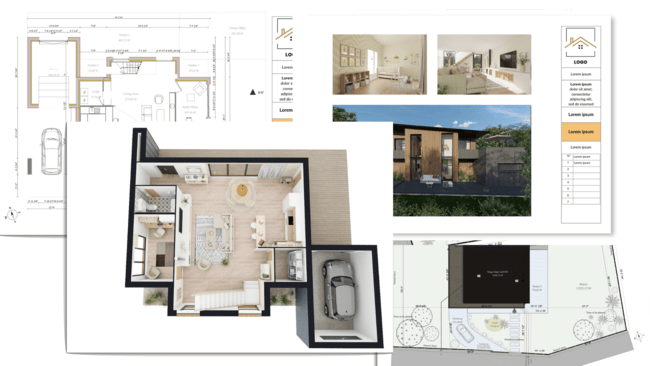
An architecture presentation board is a visual tool used by architects and designers to convey the concepts, details and essence of their architectural projects. It combines images, drawings, text, and sometimes physical materials, to provide a coherent and appealing overview of a project.
These boards are pivotal in architectural competitions and client presentations since they serve as a bridge between the architect’s vision and the client’s understanding.
But presentation boards should be more than just a random collection of visuals.
- Use your board to tell a story and guide the viewer through the project’s inception, development, and final design.
- Effective boards balance aesthetics with information by employing a strategic layout to highlight key elements and facilitate easy comprehension.
- Presentation boards can vary in format from digital displays to large printed panels.
Check out the next section to see the 8 steps to creating your presentation board.
How to Develop Architectural Presentation Boards
Developing architectural presentation boards that stand out requires a blend of creativity, strategic planning, and technical skills. Here’s a step-by-step guide to crafting boards that showcase your project and impress potential clients.
1. Size & Orientation
The size and orientation of your presentation board are foundational decisions that set the stage for the rest of the board’s design.
Size: Consider the amount of content and the level of detail you wish to present. Larger boards can accommodate more information and are suitable for complex projects but require careful organization to avoid overwhelming the viewer. Standard sizes often range from A3 for smaller projects to A0 for more detailed presentations.
Orientation: The choice between landscape and portrait orientation can influence the flow of your presentation. Landscape is preferred for its width which facilitates a natural, left-to-right reading flow. It’s ideal for showcasing panoramic site views or extensive floor plans.
PRO TIP :
- Always tailor the size and orientation to the context of your presentation. For intimate settings, a smaller board might be more practical since it allows for closer viewing and discussion.
The layout of your board is critical in guiding the viewer’s eye through your presentation. This ensures they focus on key elements without missing important details.
Balance and Flow: Create a layout that balances visual elements, text, and white space. Start with the most impactful images or drawings positioned centrally or towards the top, where they attract immediate attention. Use text sparingly to complement the visuals rather than overwhelm them.
Hierarchy: Establish a visual hierarchy that leads the viewer through your board logically, from the project overview to specific details. Use different sizes and styles of text and images to denote importance.
- Use grids to align elements. This creates a professional appearance and makes your board more readable.
- Consider color blocks or frames to delineate different sections without cluttering the board with too many lines.
DON’T FORGET:
- Keep a consistent margin around the edge of the board. This ‘frame’ ensures that none of your content is lost if the board is mounted or encased.
3. Structure
The structure of your presentation board is about more than just where things are placed. It’s about creating a coherent flow that guides the viewer through your design.
Organizational Strategy : Start with a clear organizational structure, such as chronological, thematic or by the project phase. This helps in making your presentation logical and digestible.
Connectivity: Ensure there is a clear connection between different elements on your board. Use lines, arrows or even a numbered path to indicate the order in which the content should be viewed.
PRO TIP:
- Incorporate an “Introduction” and “Conclusion” section on your board. An introduction at the top left can set the stage for your presentation. Then, a conclusion at the bottom right summarizes the project outcomes or next steps.
DON’T FORGET:
- The viewer’s eye naturally moves from left to right and top to bottom. Place your most important information (like the project title or key visuals) where viewers will likely see it first.
4. Background
The background of your architecture presentation board plays a crucial role in setting the tone and making your content stand out.
Simplicity is Key: Opt for a simple, non-distracting background that enhances the readability of your content. A subtle gradient or a light texture can add depth without overpowering the visuals and text.
Contrast: Ensure there is enough contrast between the background and the content to make everything easily readable. Light backgrounds with dark text and visuals usually work best.
PRO TIP:
- Experiment with soft, architectural textures as backgrounds to add a thematic touch to your board without overwhelming the main content.
DON’T FORGET:
- Always preview your board in its final form before printing or presenting. What looks good on a computer screen may not translate well to a large format print or display.
Colors can evoke emotions, highlight important information, and organize your board visually.
Color Scheme: Choose a color scheme that complements your project. Use your project’s primary colors, or select a palette that reflects the project’s mood and context. Consistency in color usage across the board ties the presentation together.
Accent Colors: Use accent colors sparingly to draw attention to key areas or important details. This can be an effective way to guide the viewer’s eye through the board.
- A limited color palette (2-3 main colors) can help in maintaining visual coherence and professionalism.
- Consider the psychological impact of colors. For example, blue can convey trust and stability, while green might be used to emphasize sustainability or environmental aspects.
6. Visual Ranking
Visual ranking on your presentation board ensures that key elements capture immediate attention and then guide the viewer through your design story.
Prioritize Content: Decide what elements of your design are most important and deserve the prime real estate on your board. Typically, this includes your main concept image, and key plans or sections.
Size Matters: Larger images attract more attention. Use size strategically to emphasize the most critical aspects of your project. Smaller images can show less important, but still relevant, information.
- Use visual contrast through varied textures or color highlights to elevate important content further. A high-contrast backdrop for your most crucial images or diagrams can make them stand out.

7. Image Selection
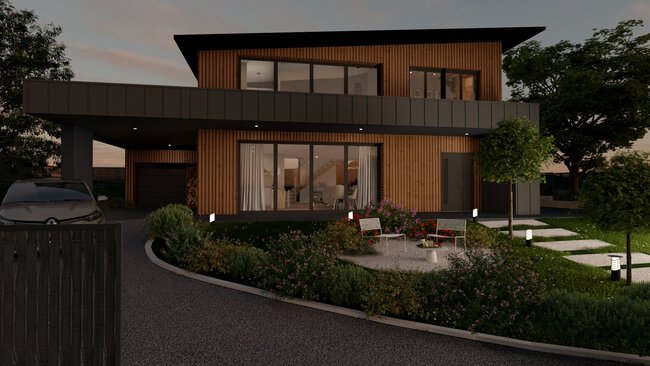
The images you choose to display on your architecture presentation board can make or break your presentation.
Quality Over Quantity: Select high-resolution images that clearly communicate your design. Blurry or pixelated images can detract from your professionalism.
Relevance is Key: Every image should serve a purpose, whether it’s to showcase design details, illustrate spatial relationships or convey the atmosphere of your proposed project.
PRO TIP: If you plan to use 3D-generated images, make sure they are high-quality. Poor-quality, unrealistic images can detract from your design presentation. That’s why more and more housing professionals are switching to easy-to-use 3D design software like Cedreo . Cedreo makes it easy for anyone to generate photorealistic 3D project images for architecture presentation boards.
8. Text & Font
The text and font choices on your presentation board are vital for communicating your design intent clearly and effectively.
Legibility is Crucial: Choose fonts that are easy to read at various sizes. Sans-serif fonts are often preferred for their clean lines and readability in both digital and print formats.
Hierarchy Through Typography: Use different font sizes and weights to create a visual hierarchy in your text. It should be easy for viewers to distinguish between titles, headings and body text.
- Limit your presentation to two fonts to maintain visual coherence—one for headings and one for body text. This simplifies the design and enhances readability.
Types of Architecture Presentation Boards
Understanding the different architecture presentation board templates and layouts is essential for selecting the most effective way to communicate your project’s vision. Each type serves a unique purpose and audience, from conceptual designs to detailed technical drawings.
Here are a few architecture presentation board examples.
Conceptual Board
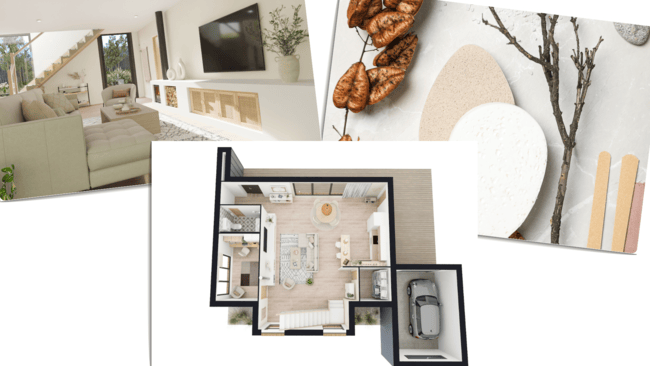
Conceptual boards are the storytellers of architectural design. They focus on the vision, ideas, and themes behind a project. They are less about detail and more about conveying the concept and atmosphere of the design.
- Use compelling visuals that evoke the intended feel of the project, such as mood boards, abstract diagrams, and 3D floor plans .
- Include brief text descriptions or quotes that capture the essence of your design philosophy and the main concept behind the project.
Advice: Conceptual boards are your chance to connect emotionally with your audience, so choose images and words that resonate deeply with the project’s core idea. Remember: The goal is to intrigue and inspire while making viewers curious and excited about the potential of your design.
Technical Drawings Board
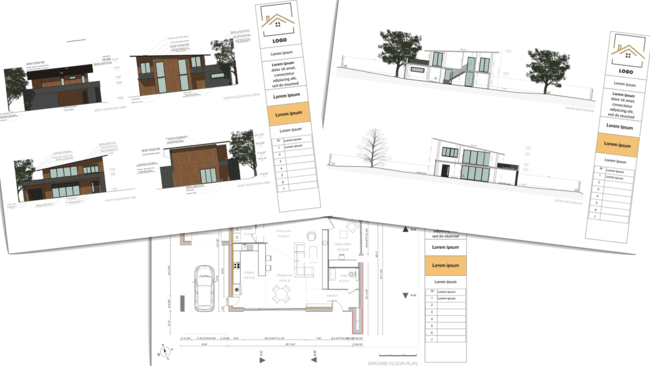
Technical drawing boards detail the specificities of the design through precise drawings and specifications.
- Incorporate a range of technical drawings, including floor plans , elevations , sections , and detailed construction drawings , to provide a comprehensive overview of the project.
- Use annotations, dimensions, and notes to clarify the technical aspects and innovative solutions within your design.
Advice: Make sure your technical boards are meticulously organized and labeled to ensure clarity and ease of understanding. Remember: While technical accuracy is important, consider the layout and visual appeal of your board to ensure it remains engaging and not overly dense.
Professional Board
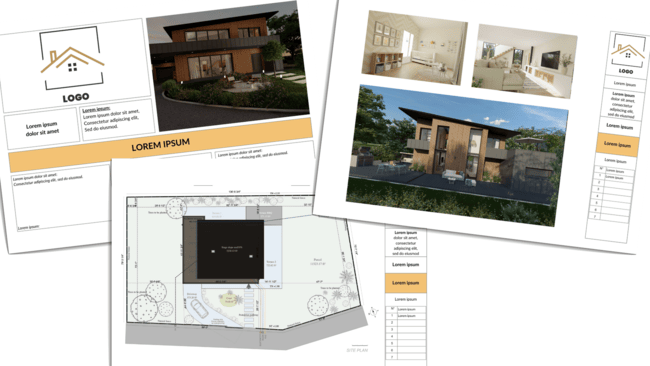
Professional boards are tailored for client presentations, competitions, or public exhibitions. They blend both conceptual and technical elements to present a complete story.
- Combine striking visuals, key technical drawings, and succinct, persuasive text to showcase your project’s strengths and feasibility.
- Balance the layout to highlight the most compelling aspects of your design while ensuring a logical flow that guides the viewer through the narrative.
Advice : Professional boards are your portfolio’s highlight reel. Focus on quality over quantity and make sure to select only the most impactful images and information that demonstrates your vision.
Remember : Take the time to get it right. A well-executed professional board is a powerful tool for winning bids, gaining approval, and impressing stakeholders.
Get Designing with Cedreo Today!
Crafting an architecture presentation board that effectively communicates your vision and details can be a daunting task.
Whether you’re creating a simple conceptual board for a small project or a detailed technical board for a custom home, Cedreo empowers you to make the best boards as fast as possible.
- Rapid Visualization: Cedreo lets you quickly transform your ideas into visual concepts, with easy-to-use features that save you loads of time and effort.
- One-Stop Solution: From initial sketches to final presentation boards, Cedreo offers a comprehensive platform for all your design needs.
- High-Quality Outputs : Produce professional, high-resolution 3D presentation board images that impress clients and showcase your projects in the best light.
Get started with Cedreo now (there’s a FREE version !) and take your architectural presentations to the next level.
Take Your Designs to the Next Level with Cedreo

The Average Bathroom Size? Here’s What’s Best for Your Projects
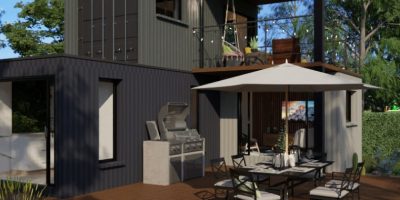
Modern Container House: Trends, Tips & Inspiration
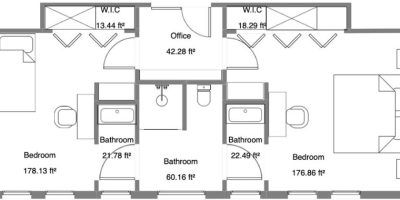
10 Best Blueprint Software Programs for Residential Design Pros
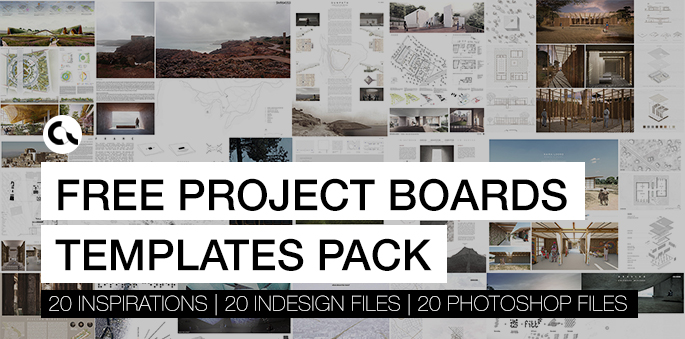
Free Project Boards Templates Pack | 20 Inspirations
Competitions.Archi in collaboration with winners of architecture competitions launched in previous years prepared Project Boards Template Pack . It is a set of 20 free panels templates of awarded projects in PhotoShop and InDesign formats. Here you can find 20 Inspirations for your presentation board, which are easy to transform and edit. They grabbed attention of the jury panels once, so they will do it again, for sure!
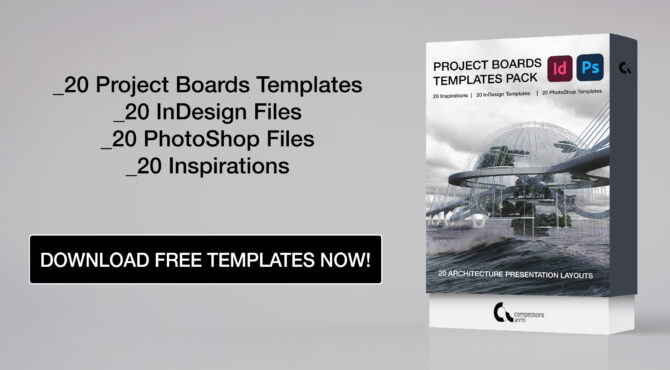
It is very important to have stand-out architecture boards during your final presentations at the universitiy as well as while submitting your competitions entries. Competitions.Archi realized that composing the representation boards is sometimes very demanding and is trying to help all students by offering free inspirations for their designs. Project Boards Template Pack is a wide range of presentation boards layouts, which look extraordinary and will help you to achieve the brilliant final result.
What is inside?

There are 20 layout examples inside the Project Boards Template Pack. They were prepared on the base of the best competitions entries and now available as editable 20 Photoshop and 20 InDesign files completely free. There are 10 landscape and 10 portrait layouts as well. Every template can be adjust to your design. Nevertheless, if you need inspiration, there is always an example how final presentation board may look like, which can be found in Tables of Contents. There are also short instructions how effectively use .psd and .indd files and videos showing how the templates can be transformed into a recognizable representation boards, by using drag-and-drop tools and smart objects . All files are prepared to be used very intuitive even for the beginners in graphics software.

Most popular competitions

People also viewed
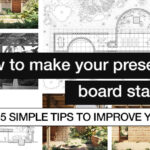

Architecture Presentation Board Ideas
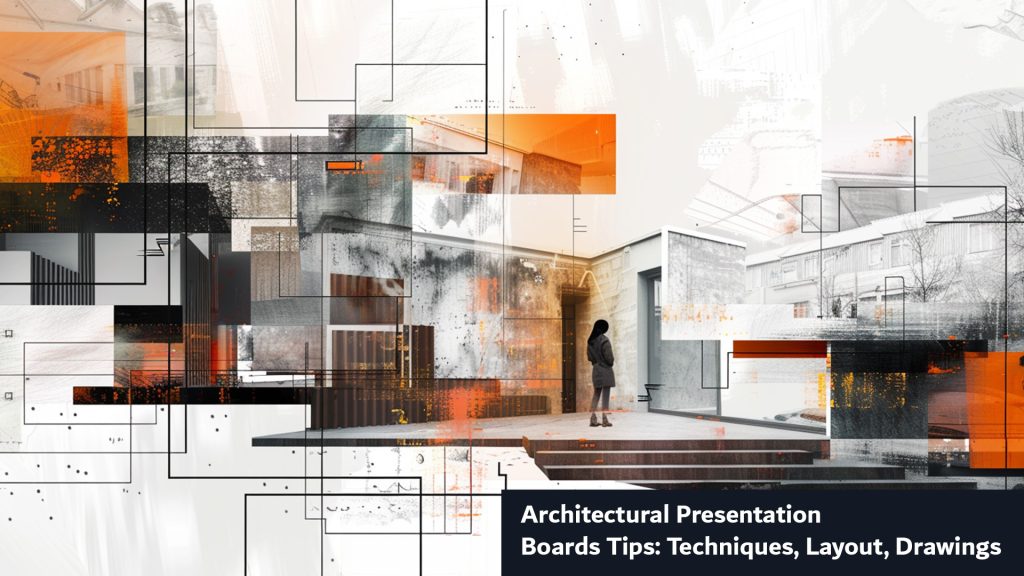
- Request a Quote
Being an architect, you understand that showcasing your project effectively to the stakeholders is very essential. The architecture presentation board examples helps make that right impact in the first go. These architecture presentation board drawings ensure that your idea is beautifully expressed and is conceived the same way as you have thought.
But creating and designing the architectural presentation is a challenging task as a slight mismatch or mistake can completely ruin your architectural project. It’s very important to design the presentation board in such a way that it can communicate your ideas cohesively and engagingly.
Best Architecture Presentation Board Ideas
Let’s have a look at 8 critical elements of architectural presentation boards design that’ll help you craft a polished and visually captivating presentation. Just go through these tips and enhance your ability to showcase your architecture projects impactfully and impressively.
What do you mean by an architecture presentation board? How it is helpful?
An architecture presentation board is a visual summary of a project, used by architects to showcase their designs to clients, superiors, or colleagues. It serves as a tool for presenting ideas, attracting clients, and advancing careers. The purpose of an architectural presentation model is to convey essential project information in a self-explanatory manner.
Key elements of an effective architecture presentation board layout include:
- A well-designed layout that organizes and presents information in a logical and visually appealing way.
- Clear and concise text that explains the project’s concept, goals, and solutions.
- High-quality visuals, such as drawings, renderings, and photographs, that illustrate the project’s design and features.
- A consistent visual style that creates a unified and professional look.
Architecture presentation drawings are used by both students and professionals. Students use them to present their work to professors and peers, while professionals use them to present designs to clients, committees, shareholders, and exhibitions.
Top 8 Architecture Presentation Board Tips and Techniques
To help you get started, Renderspoint has exclusively curated some of the best architectural presentation board techniques and tips that must be considered when creating your architecture presentation board. So, let’s get started in our journey to create flawless architecture presentation board tips for clients.
1. Size and Orientation of the Architecture Presentation Board
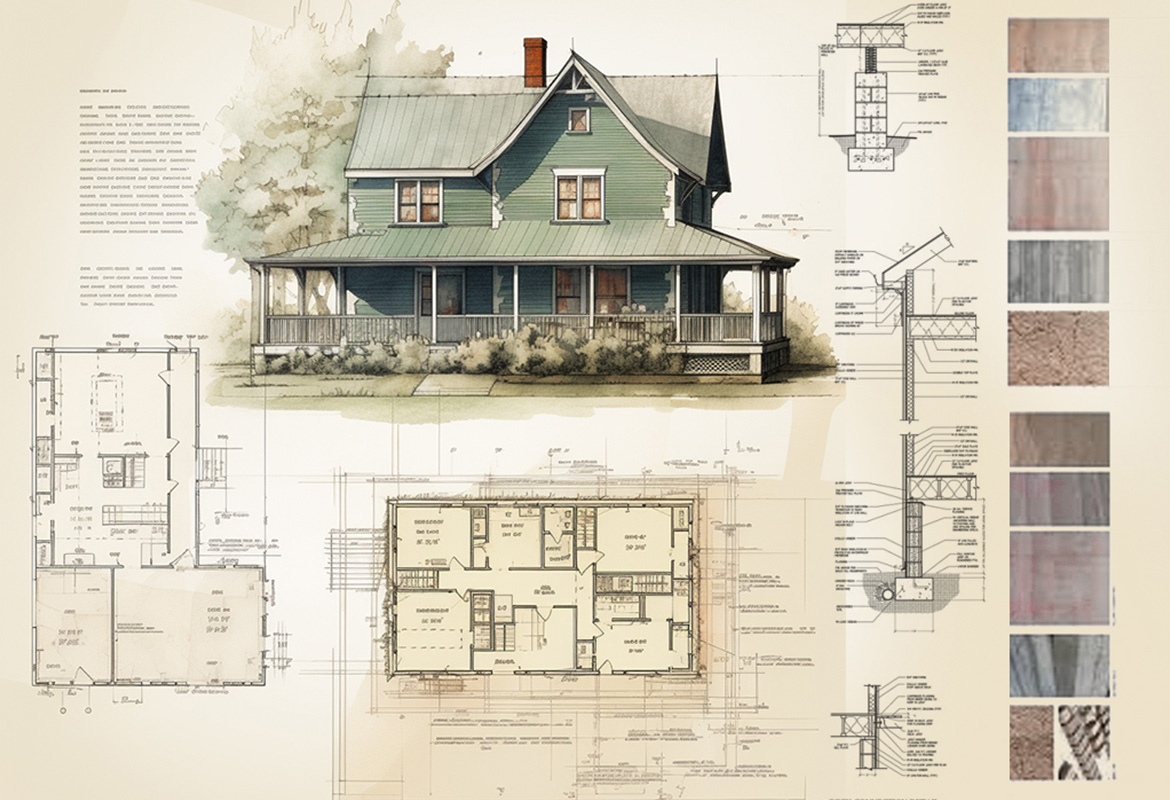
When creating an architecture presentation model, consider the size and orientation that will best showcase your project. You may have limited options due to restrictions imposed by your director, client, or professor. If you have the freedom to choose, think about which orientation will make your graphics stand out and tell the story of your project most effectively.
Presentation Options:
- Single Large Board : Present your boards side by side as a single large board. You may choose horizontal or vertical architectural presentation boards depending on the requirements of the project.
- Equivalent-Sized Poster : Present your boards as one poster of equal size.
- Separate Boards : Arrange your boards in a sequence, with each board presenting a different aspect of your project.
The orientation and size of your architecture presentation board can influence the structure and layout of your presentation. Choose the option that best suits your project and allows you to communicate your ideas clearly and effectively.
2. Choosing the Right Layout for your Architectural Presentation Board Drawings
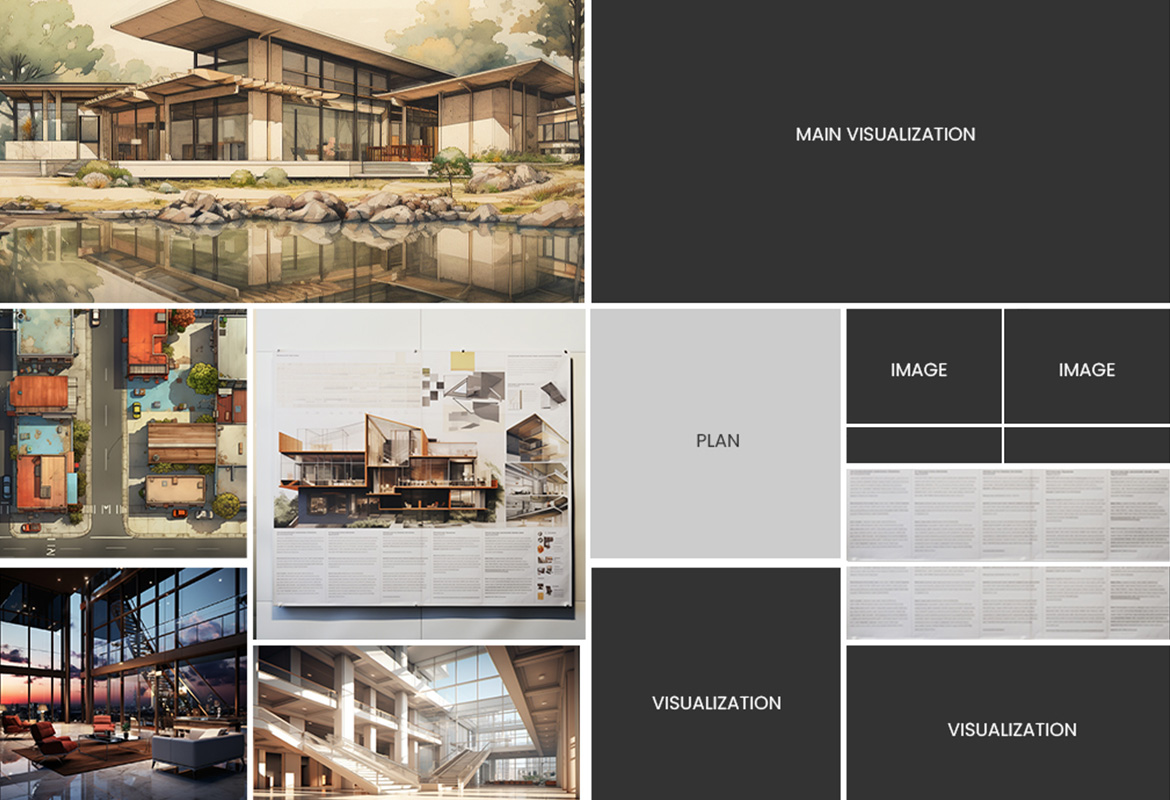
It all starts with brainstorming for the right layout. Brainstorm and jot down the main ideas you want to express. Also, work on the images and graphics that will best showcase those concepts. Now start creating small-scale sketches to capture the basic flow of each architecture presentation board. Before finalizing your design, keep experimenting with different element placements until you get the perfect one. You may explore some architectural presentation board layout examples online for some cool and best ideas.
Be very diligent regarding the space allocation. Determine how much space each element will require on the page. Ensure each graphic is impactful and consider the amount of space between elements. Avoid overcrowding or excessive space. By carefully planning the layout of your architecture presentation board, you can ensure that your ideas are communicated clearly and effectively.
Also, work on the size of images. Too small an image will fail to make that impact. Try to go for big and visually appealing images/graphics. You can even approach a 3D architectural rendering firm as 3D renders give a more photorealistic option to impress the stakeholders. Remember, the goal is to create a visually appealing and informative presentation that effectively conveys your project’s message.
3. Structure and Flow for a cohesive Architecture Presentation Board Style
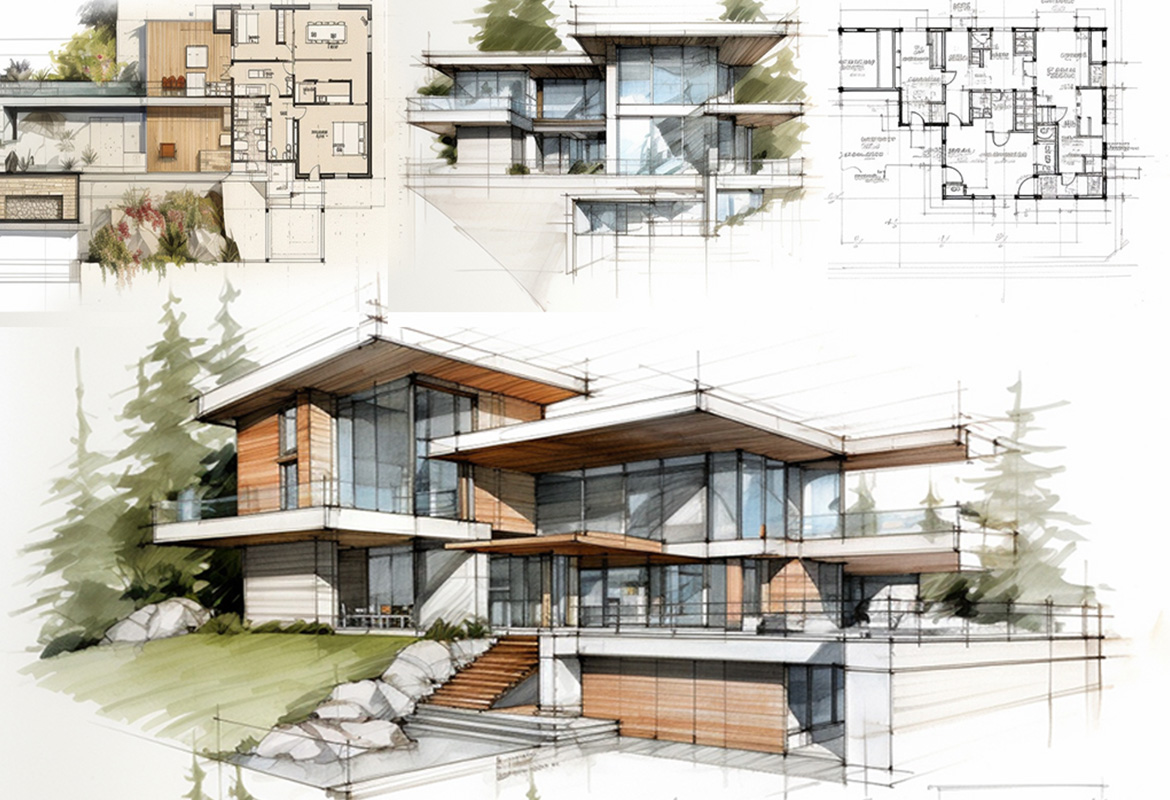
The structure and flow of your architecture presentation board are crucial for effectively communicating your project’s vision. Using a grid structure can simplify the organization of visual elements, while diagramming helps deliver comprehensive information. Consider the narrative flow of your project, ensuring a logical progression from one architecture presentation board to the next. Number your boards if they won’t be displayed simultaneously.
Remember, viewers typically read presentations from left to right and top to bottom. Use visual cues to guide their eyes through your architectural presentation models. Maintain consistency in font, colour, and style throughout your architectural presentation boards. Leave sufficient white space to avoid overcrowding. Finally, proofread your text carefully for errors. By carefully following these professional architectural presentation board techniques, you can create a visually appealing and informative presentation that effectively conveys your architectural vision to your audience.
4. Visual Hierarchy of Architecture Presentation Board: Guiding the Viewer’s Eye
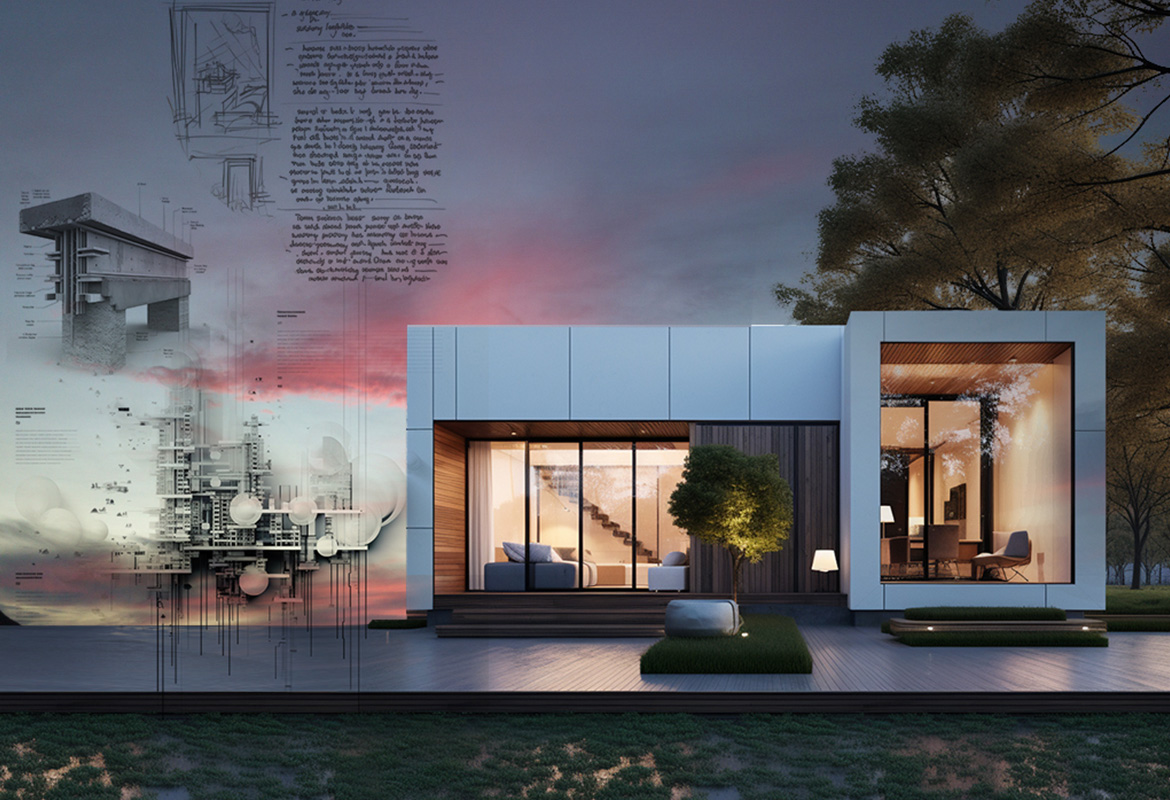
In architecture presentation board, visual hierarchy plays a crucial role in directing the viewer’s attention to specific images. This involves identifying the strongest point of your project and making it the primary focus that catches the eye from a distance. Other images should reveal their details upon closer examination.
Techniques to Create Visual Hierarchy:
- Size : Make the image you want to highlight the largest, ensuring it can be viewed clearly from a distance.
- Colour : Use colour strategically to guide the viewer’s eye toward the main idea on the board.
- Placement : Centre the image you want to highlight and arrange the surrounding content to complement it.
Additional Tips:
- Keep the overall vision of your project in mind when selecting images.
- Choose images that directly display and strongly support your project’s idea.
- Avoid using too many images that will make the board look cluttered and messy.
- Maintain consistency in the style and tone of your images.
By carefully considering visual hierarchy, you can create conversion-ready architectural presentation drawings that effectively communicate your architectural vision and guide the viewer’s eye to the most important elements of your project.
5. Choosing Perfect Colours: Bringing Life and Focus to Your Architecture Presentation Board
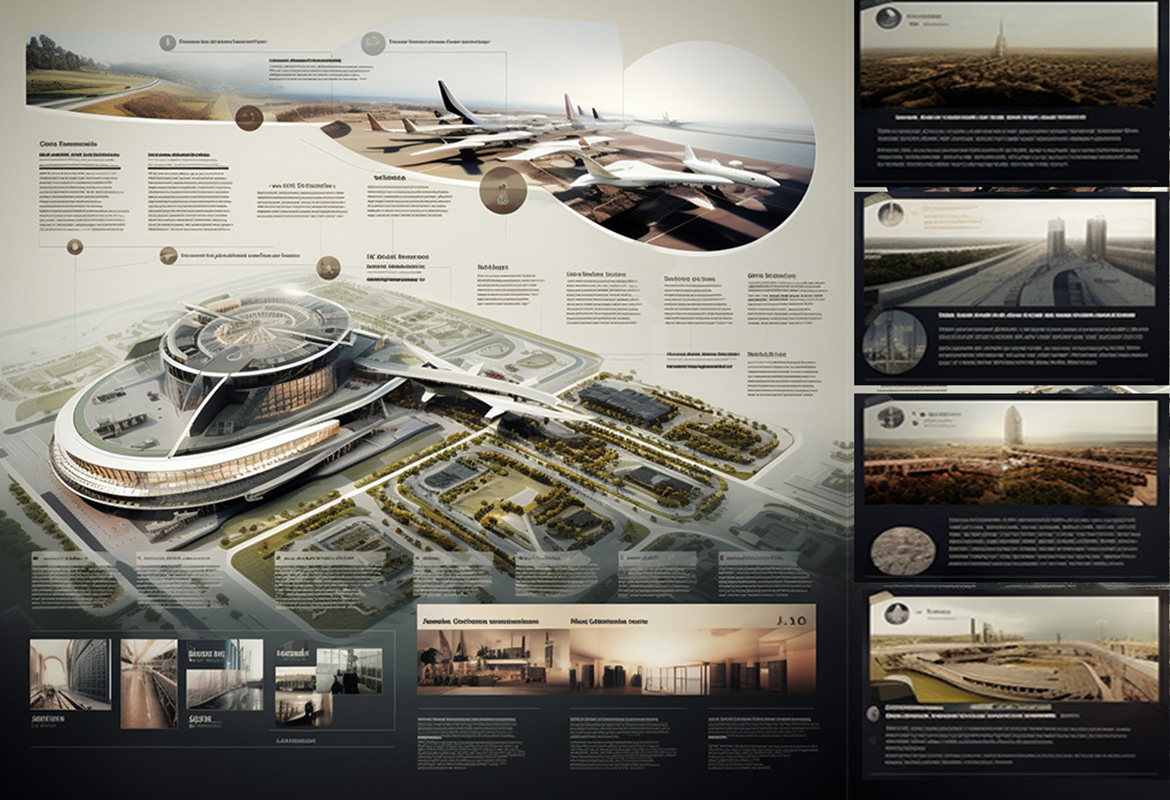
This is one of the most critical architectural presentation board techniques that you need to decide very wisely. While black, white, and grey are commonly used in architecture presentation boards, don’t shy away from incorporating colours. However, be mindful of your choices to strike the right balance and avoid overwhelming the viewer. Here’s how you can make strategic use of the colours in your presentation architecture style.
- Introduce hints of colour to bring life to your architecture presentation board.
- Use colour contrast as it helps to draw attention to elements you need to focus on.
- Represent different building materials with unique colours.
- Consider bold colours for diagrams to create a focal point.
Maintain consistency by using the same colour across all architectural presentation boards. This approach ensures a cohesive and seamless flow throughout your presentation. Also, you may explore pre-made colour palettes online for inspiration. Experiment with different colour combinations to find the best fit for your project.
6. Selecting Background Colour: Enhancing Clarity and Focus
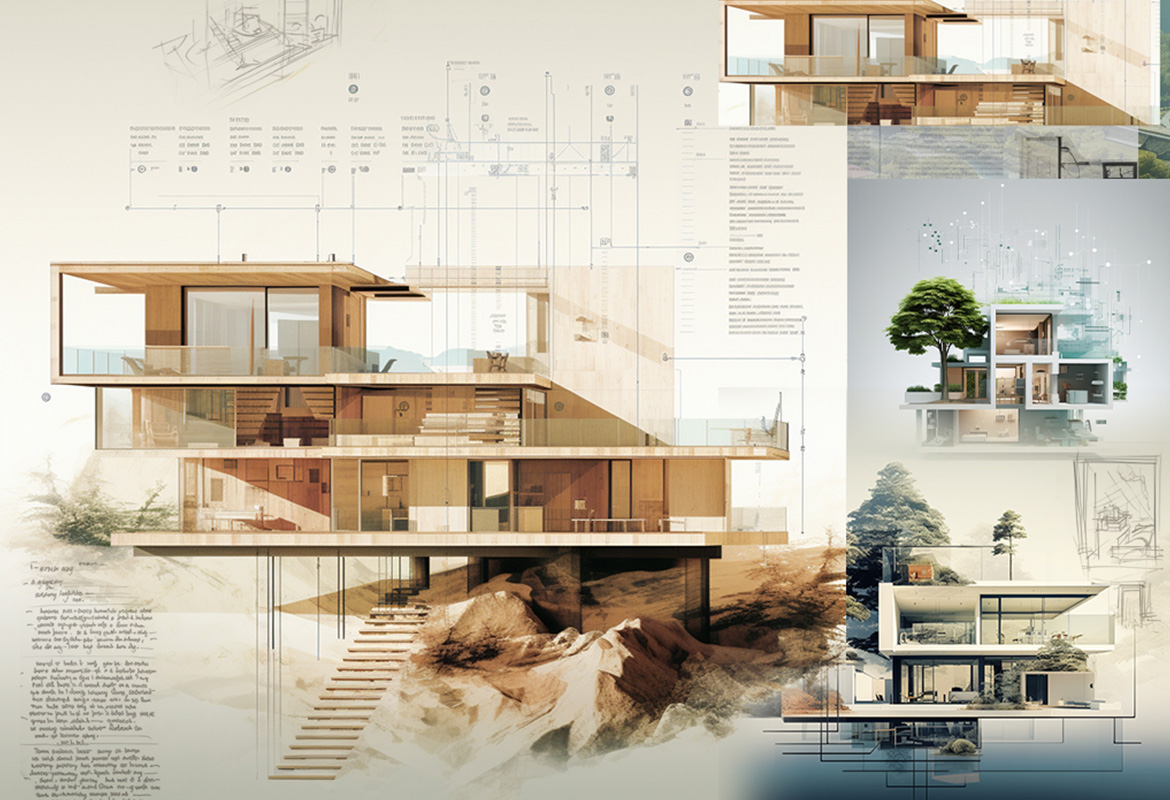
The background of your architecture presentation board should be a supporting element, not a distraction. Avoid complex or busy backgrounds that may draw attention away from your graphics and text. Bold colours and textures should be used sparingly, if at all. Here are three key things that you need to keep in mind while selecting a background colour for your architectural presentation board.
- Black Background: Use with Caution
Black backgrounds can be challenging to work with. They can diminish text readability and reduce the impact of graphics. Additionally, black backgrounds can create a cold and boring tone. If you choose to use a black background, ensure that all information remains easily comprehensible.
- White or Light Gray: A Professional Choice
White or light grey backgrounds are typically the best choice for an architecture presentation board. They enhance the visibility of graphics and text, creating a professional and clean appearance. Other colours can be incorporated to align with your central concept but ensure that the background remains plain enough to direct the viewer’s attention to the design.
- Embrace Negative Space
Negative space is your friend. Resist the temptation to fill every space with information. The strategic use of negative space enhances the impact of your design, creating a clean and professional feel.
7. Image Selection: Striking the Right Balance
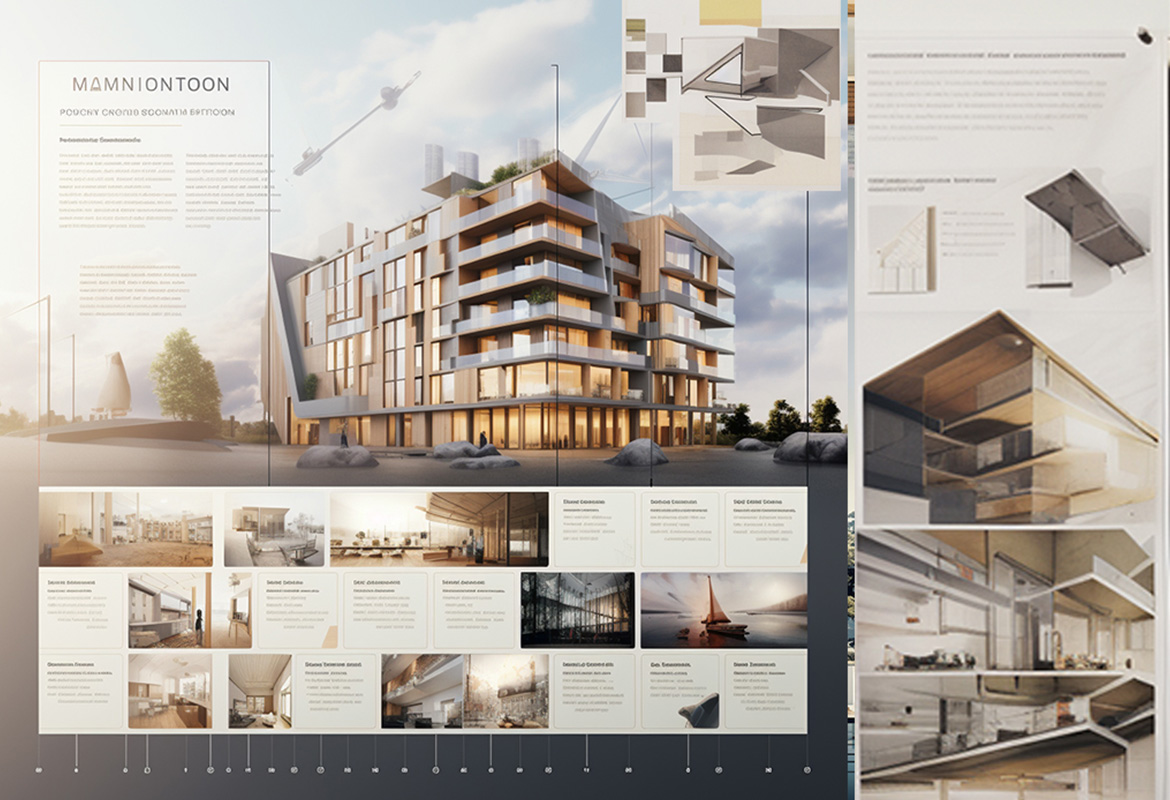
Choosing the right images is crucial for creating an effective architecture presentation board. Your graphics can either enhance or detract from your overall presentation. Always go for high-quality images/CGI and ensure that they are relevant, engaging, and catchy.
As already stated just use enough images to effectively communicate your project. Avoid overcrowding your architecture presentation board with too many images. strive for a balanced representation that showcases your project’s key aspects.
You may include a variety of images, such as sketches, models, renderings, and drawings. This approach provides a comprehensive overview of your project.
8. Content, Text, and Font: The Impression Makers
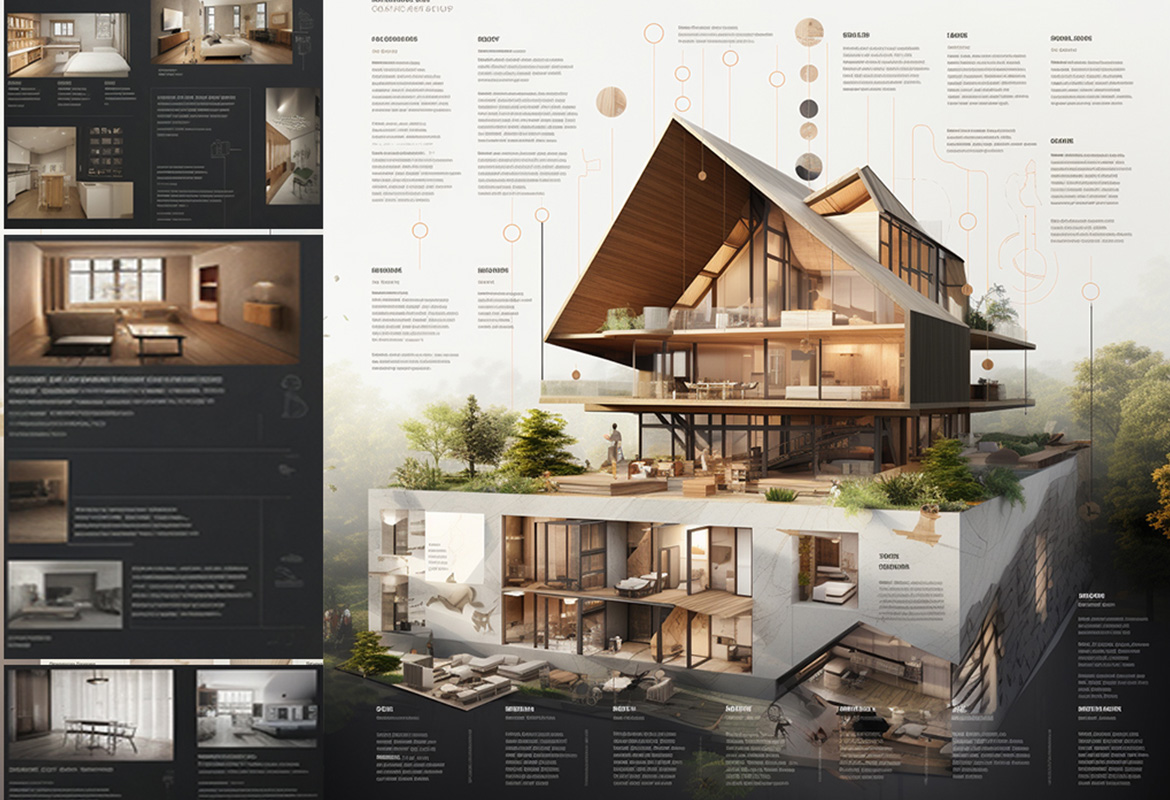
An effective architecture presentation board should convey a clear understanding of the project and demonstrate the designer’s commitment and dedication. Key elements to include are internal and external images, isometric and exploded views, perspective cuts, diagrams, volumetry studies, descriptive memorials, and technical drawings. The specific elements used may vary depending on the project’s requirements and nature.
Make sure the text that you place on the architecture presentation board should complement the layout and try to keep it minimum. A crisp, concise, and focused concept statement will make your architecture presentation board more impressive and attention-grabbing.
Additional tips that will enhance your communication power using texts on the architecture presentation board.
- Consider readability, flow, and visual appeal.
- Align text within text boxes for easy reading.
- Complement graphics/images/CGI with text box size and alignment.
- Avoid all capitals except for titles and follow standard capitalization rules.
- Use simple sketches and figures instead of text when possible.
Select a single font type that complements your project’s style. Sans Serif fonts like Futura or Helvetica are popular choices for their clean and modern look. Avoid script or handwriting fonts for a professional appearance. Use dark hues for your font to ensure contrast against a light background. Choose a font and size that is easy to read and create a hierarchy using different font sizes for titles, subtitles, and body text.
Win More Clients with Perfect Architectural Presentation Boards
Hope you liked our tips and techniques to make your architecture presentation board impressive and converting. At, Renderspoint, we offer you the best 3D CGI that will ace up your architecture presentation board styles and help you communicate in a never-like-before way. Reach out to us for eye-catching and engaging 3D visualization such as 3D rendering, modelling, floor plans and more. Feel the magic that our 3D rendering studio experts cast on your images.

Color Psychology in Architectural Design: Meaning & Importance,
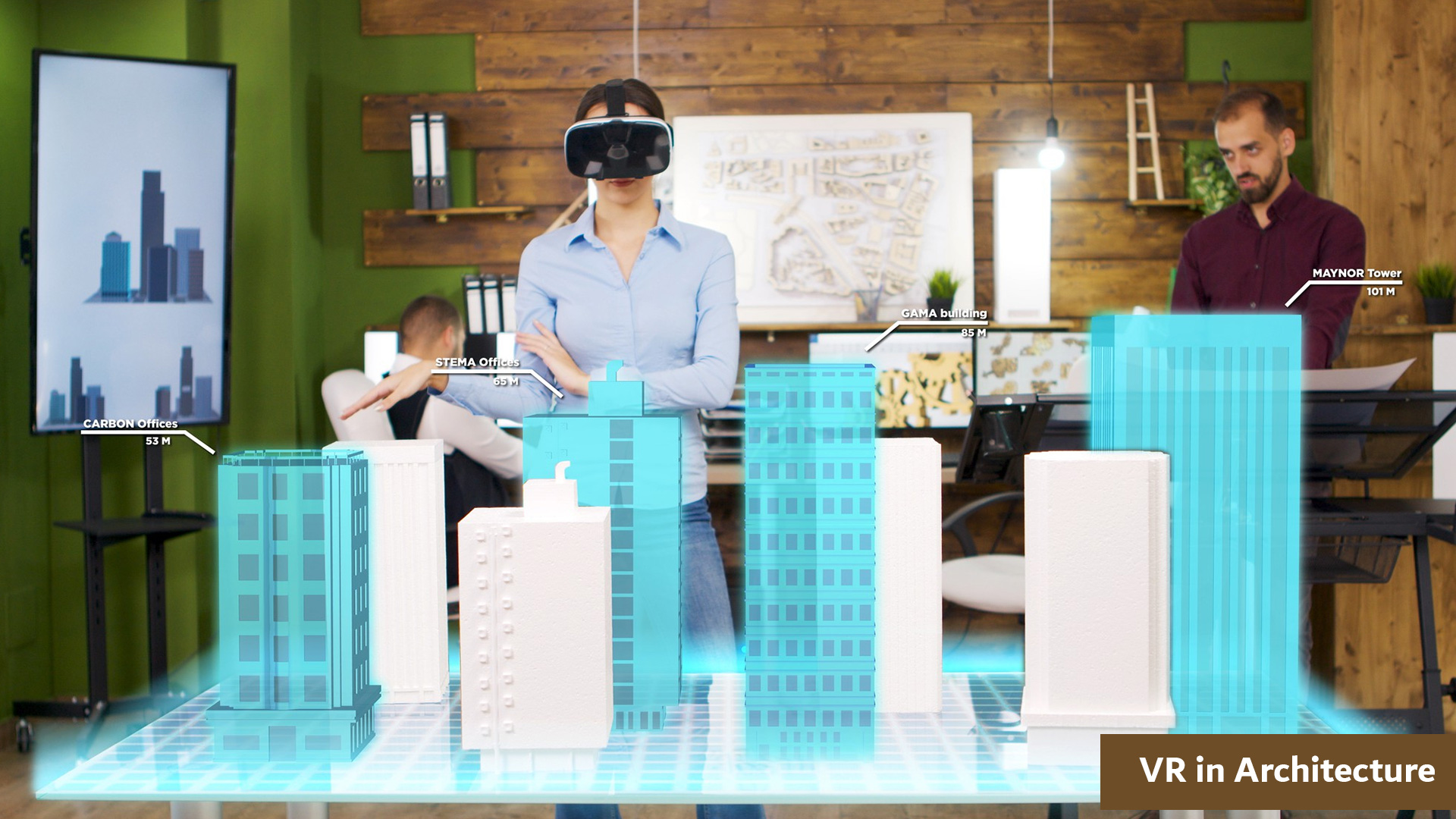
Virtual Reality in Architecture: Use, Benefits, Case Study
Get started, make a request.
Open up a new world of Opportunities with Renderspoint. Connect Now!
We’re always excited to hear about new opportunities to make great work

High-Quality & Budget-friendly 3D Rendering Services
Get Impactful, detailed and authentic 3D renders to make your designs resonate with client`s expectations and needs. Partner with us for fully integrated rendering services that make you stand above your competitors!

Successful Architectural Presentation Boards
- by Elif Ayse Sen
- 7 June 2022
Presentations are visual tools that represent your projects and works in architecture for you. Architectural presentations are designed both for juries and submissions during student years and for customers in professional life. Architects present their projects of different scales as architectural presentation boards . In this article, while we talk about the importance of architectural presentation sheets, we will show you the best examples among presentation boards.
Table of Contents
How to Develop Presentation Boards
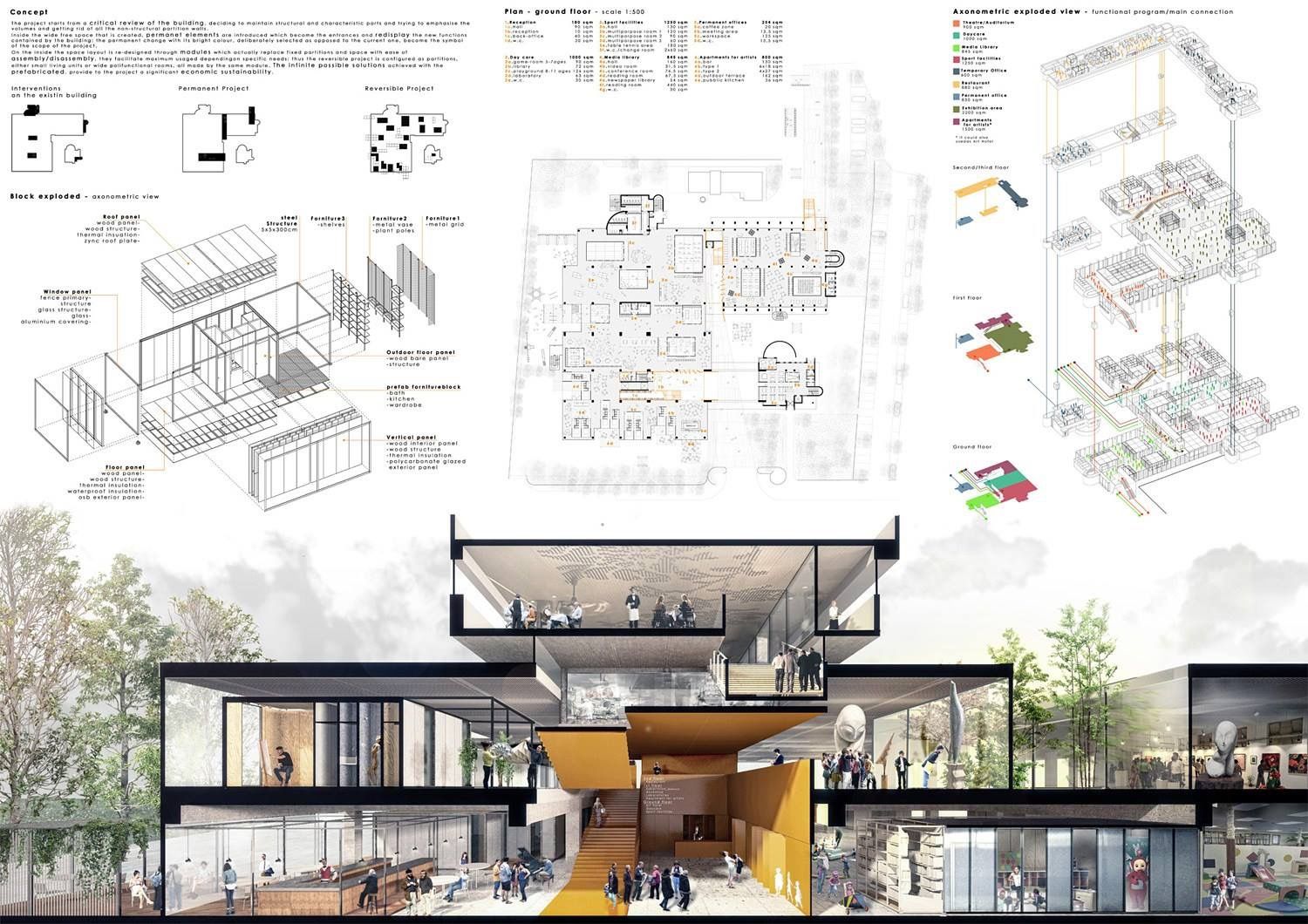
If you want to prepare your architectural presentation boards in a better version and improve yourself, there are a few steps you need to follow. First of all, no matter the scale of your project, from urban design to presentations of interior design projects , your reference generally comes from the concept. The architectural concept is involved at every stage of the design. Your concept also affects the presentation board’s layouts, color choices, font preferences and design language of your diagrams.
Preparing a successful architectural presentation sheet means standing out both for the competition sheets and for the judges at school. In order for the architectural presentations to be appreciated by the juries, your layouts must have clear and understandable designs.
To be successful in this regard, we recommend that you prepare boards with simple and understandable layouts. Also important is the color tones you use to relate to your concept. The colors you choose should be compatible with your projects and should not affect the presentation.

Posters with a simple and understandable layout are not dense in content. The content of the posters may vary according to the layout topics. These topics are analysis sheet, concept sheet, technical drawing sheet or sheets prepared for the presentation of architectural projects to customers in professional life under the headings we have listed below.
In architectural presentation sheets, it is very important to prepare the contents of the posters according to their subjects. We do not want the jury reviewing your presentation to encounter analyzes while reading your project on the concept. In order to present your project in the most effective way with all its phases, you can choose well-designed layouts and sheets separated by simple design language.
Types of Architectural Presentation Boards
It is one of the most effective presentation methods to separate the architectural presentation sheets you have designed to present your projects according to their subjects. Below, let’s look at the types of architectural presentation boards and how to present your project in different phases:
Conceptual Board
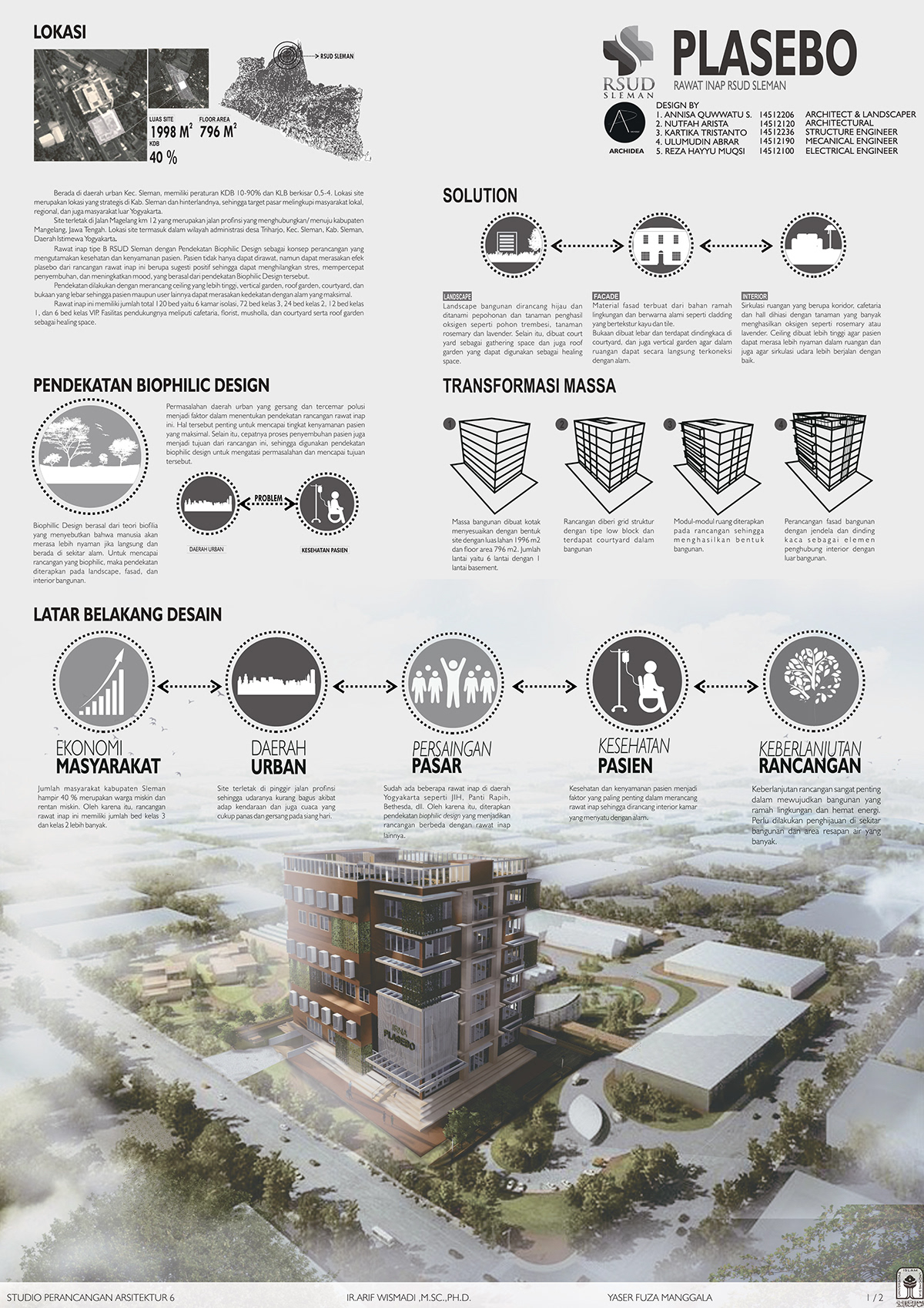
Concept sheets consist of posters where you present your approach to the project. It includes what concept an architectural project starts with and how mass decisions are made. Concept boards should be submitted before your architectural drawings and render images. While creating concept boards, you must prepare conceptual collages. From your analysis, you can present all the elements that inspire you while developing the concept with a collage. In addition, it is important that you represent your idea in the simplest and most understandable way with conceptual diagrams. As we mentioned in our previous articles, conceptual diagrams can be created through the 3D modeling software you work with or Adobe Photoshop/ Illustrator. Conceptual diagrams are necessary for you to explain the phases of your project to the jury in the simplest way possible.

Technical Drawin g Board
Architectural technical drawings are important for the construction of your project and the representation of its structural elements. Especially in application projects and student projects, you should present your technical drawings completely on technical drawing boards . Technical drawing boards should start with a 1/5000 or 1/1000 scale master plan, include 1/500 scale site plans and floor plans and sections, then 1/200 scale plans and cuts. In addition, detail drawings are required for technical drawing boards. You must add the system sections and detail drawings in 1/20, 1/10, 1/5 scale in these boards.
Analysis Board
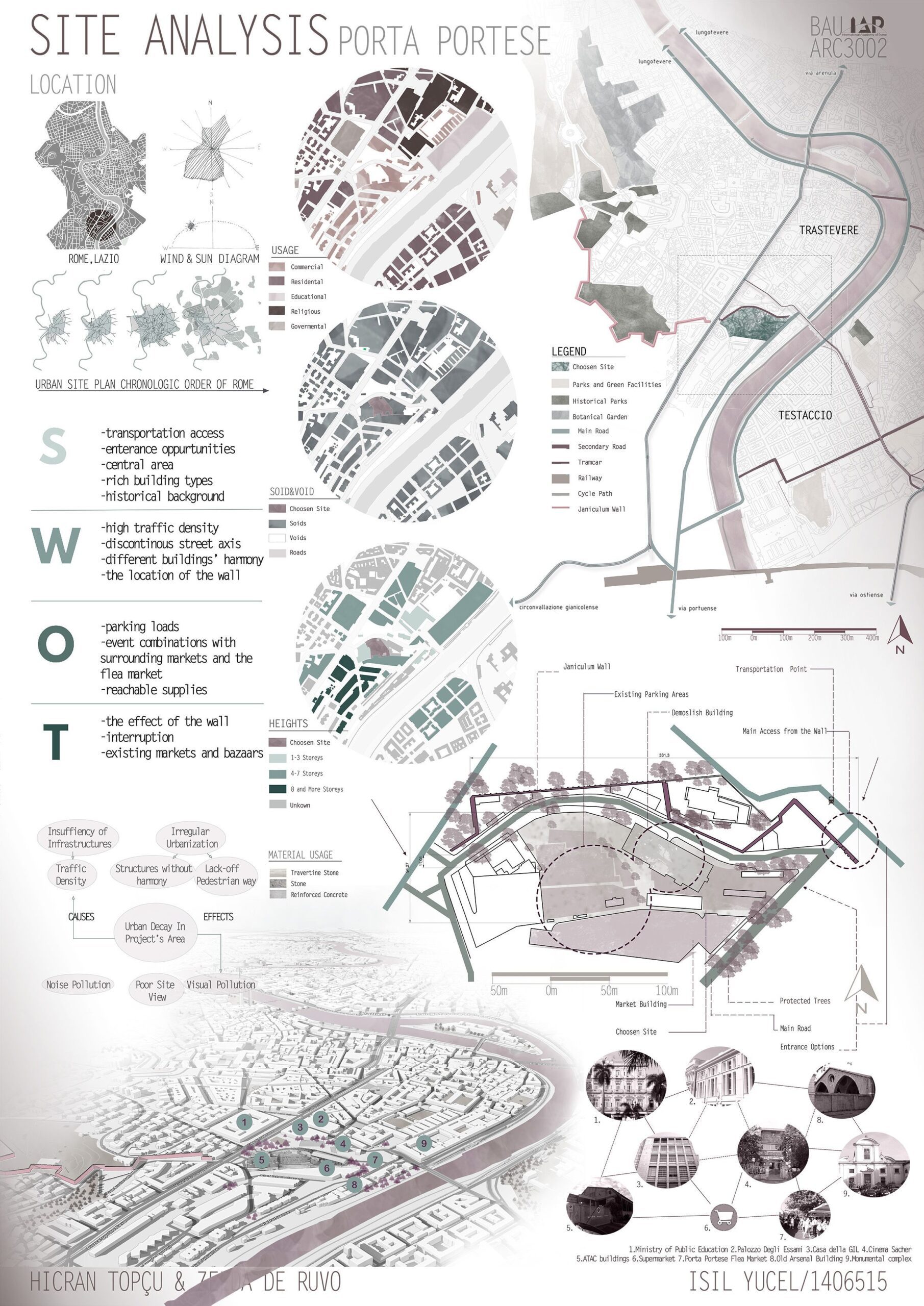
Architects make detailed analyzes before starting the project and as a result, they determine the needs, conditions and deficiencies. Even developing a concept begins as a result of the analysis. Site analysis, urban scale (e.g. Lynch) analysis, sociocultural analysis, analysis of physical conditions (e.g. climate, geography etc.), environmental analysis, these can form the content of analysis boards. Most of the time, where the concept comes from depends on the research at the analysis stage. To reinforce the concepts, we recommend doing lots of analysis and designing analysis boards to present those analysis. It is certain that the analyzes presented together with the architectural drawings are not legible by the members of the jury.

Professional Boards
Student projects and competition projects are examined and evaluated by the members of the jury within a certain period of time. But in professional life, customers are your jury members!
Instead of preparing architectural presentation boards as you do for school and competition projects, you should make presentations that will attract the attention of customers. The most important criterion for a client will be the well-designed living space. Therefore, instead of filling professional drawing boards with technical drawings, you can usually include render images and plain plan drawings. The color harmony of the posters, the atmosphere in the renders and how ready you are verbally for your presentation are very important for these boars to be appreciated.
- 3D Architectural Renderings
- Architectural Display Boards
- architectural presentation
- Architectural Presentation Boards
- Architectural Visualization
- Architecture Presentation Boards Layout
- creative presentation
- design communication
- design techniques
- Designing Presentation Sheets
- Digital Architectural Boards
- Effective Presentation Techniques
- Engaging Project Presentations
- How to Design Presentation Boards
- Presentation Board Template
- presentation boards
- Professional Presentation Boards Architecture
- Successful Presetation Boards
Elif Ayse Sen
architect, writer
Architecture Paper Sizes For Architects And Students
Gift ideas for architects, you may also like.

- 4 minute read
The 5 Best Strategies To Increase Your Home’s Security
- by illustrarch Editorial Team
- 29 July 2024

Crafting a Minimalist Haven: A Guide to Designing Your Rental Space
- 28 February 2024

- 3 minute read
Exploring Basic Design Principles in Architecture
- 5 November 2023

7 Simple Ways To Use Wallpaper To Highlight Architectural Element In Your Home
- 14 June 2024

Why Should You Use Social Media Actively?
- 11 August 2022

- 5 minute read
Architectural Roofing Systems Trends and Innovations: Exploring Modern Advancements in Design
- 9 December 2024
Privacy Overview

We are excited to present a selection of 14 Architecture Presentation Board Templates in Photoshop and Indesign that all have varying layouts and fonts.
Sometimes trying to get the layout of your presentation board just right can prove to be quite difficult and time consuming – and at times you may not really know where to start.
However you’re in luck! Our architecture presentation board templates are great to get you started. They are designed to help speed up your process, create a strong design identity, and save you a huge amount of time.
All you need to do is insert your images and text into the designated placeholders. The templates can easily be adapted to suit your own style, and altered according to your own projects.

Architecture Presentation Board Templates Bundle

Let’s take a closer look at the architecture presentation board templates.

There are 14 templates in total , seven are in portrait and seven in landscape orientation. All of them come in A1 size , in Photoshop (.psd) and Indesign (.indd) formats. They can easily be sized down if needed. They include placeholders for your images and text.
7 Portrait Layouts

7 Landscape Layouts

Font suggestions
This bundle comes with our suggested ‘fonts for architects’ and ‘font combinations for architects’ to help you choose the best fonts for your presentation boards.
Textured Backgrounds

We have also included a selection of sixteen textures that you can use as backgrounds for your templates or other projects. You can use these to visually enhance your presentation boards.
There are eight original textures and eight inverted versions that you get to experiment with. So get creative and make them your own. All versions come in (.png) and TIFF file (.tiff or .tif) file format.
Here are some colour examples of the textured backgrounds:

This is how the textured backgrounds look on our presentation board templates:

Instructions and Tutorials
There is a guidance document and video tutorials included within this download that provide more detailed instructions on how to use the templates.
However if you have any questions about the templates then please feel free to drop us an email, or get in touch via the contact page.

Hurry up and get this awesome bundle to start creating some amazing presentation boards!

Other recent posts…

Roundup of the Year 2024
Roundup of the Year 2024 As the year draws to a close, it's time to reflect on the standout moments that shaped the past 12 months. This year has been one of creativity and growth for the First in Architecture team. Thank you for being on this journey with us! We are...

Average Heights / Dimensions of Person Sitting
Introduction Updated December 2024 The average heights and dimensions of a person sitting can be quite useful information for architects and designers. This anthropometric data plays a crucial role in the design of architectural spaces and furniture that prioritise...

God is in the details
Introduction ‘God is in the details’ is a famous expression associated with German American architect Ludwig Mies van der Rohe (1886-1969). Although its origins are vague, it has become a fitting way to convey the importance of thoughtfulness and precision in...
Submit a Comment Cancel reply
Your email address will not be published. Required fields are marked *
Submit Comment
This site uses Akismet to reduce spam. Learn how your comment data is processed .
This website uses cookies to improve your experience. We'll assume you're ok with this, but you can opt-out if you wish. Read More
- Always Active Necessary Necessary cookies help make a website usable by enabling basic functions like page navigation and access to secure areas of the website. The website cannot function properly without these cookies.
- Marketing Marketing Marketing cookies are used to track visitors across websites. The intention is to display ads that are relevant and engaging for the individual user and thereby more valuable for publishers and third party advertisers.
- Analytics Analytics Analytics cookies help website owners to understand how visitors interact with websites by collecting and reporting information anonymously.
- Preferences Preferences Preference cookies enable a website to remember information that changes the way the website behaves or looks, like your preferred language or the region that you are in.
- Unclassified Unclassified Unclassified cookies are cookies that we are in the process of classifying, together with the providers of individual cookies.

Important architecture presentation board tips
Take your love for architecture up a notch: preparing for interior design degrees, Furnishing style advice, Building decor tips
Top 8 Most Important Architecture Presentation Board Tips
Mar 13, 2023

Pexels The best design, drawings, and renders are not enough to land clients. You must successfully create architectural presentation boards that contain all the essential elements clients need to know about the project.
By following the tips below, you can create compelling and inspirational presentation boards that will showcase your skills and land you clients. Keep reading to find out the eight most important architecture presentation board tips.
What are architecture presentation boards?
Architectural presentation boards are tools used by architects to showcase their work. They can communicate their work and present their artistic skills using a presentation board.
An architectural presentation board is like a sales pitch where you sell your ideas, concept, and design to win clients. An architecture presentation board serves several purposes, such as:
- Use for design presentations to clients, superiors, or colleagues
- Can help land clients and earn commissions
- Can help build your career and take your architectural projects to the next level
Types of Architectural Presentation Boards
It is easier to create architectural presentation boards when you can categorize them according to type. Below are four common types of architectural presentation boards:
1. Architecture Site Analysis Board
Architects must undergo data analysis to determine the site’s current condition, needs, and limitations. The results of the analysis are the basis or foundation for your presentation board’s concept development.
A site analysis board may contain urban scale analysis, environmental analysis, analysis of physical conditions, and sociocultural analysis. An analysis board can reinforce the data found in your architectural drawings.
2. Architecture Conceptual Board
Conceptual boards are presentation boards showcasing your initial ideas and how you plan to approach the project. This board contains vital information about the project’s concept development and design process.
You can emphasize your ideas by creating conceptual boards that contain collages and diagrams. Collages and diagrams can be made using modeling software like Adobe Photoshop.
Present your conceptual board to your supervisor or client before showcasing your architectural drawings and renderings. The main goal of a conceptual board is to clearly present all the stages your architectural project will go through.
3. Technical Drawings Board
A technical drawings board is vital because it shows the structural elements of your design and serves as a guide during the construction process. It includes a master plan, site plans, floor plans, sections, and elevation views.
4. Professional Boards
Your presentation boards should be visually appealing to clients. Professional boards focus on renderings and plain plans, which are seen in the design of the living space.
Create professional boards with the appropriate color scheme and renderings. Present your boards best to clients who will evaluate your work.
Tips for a Stunning Architecture Project Presentation Board
Follow the eight tips below for a successful architecture presentation board.
1. Structure and Layout
You must plan and organize what key features you have to include in your presentation board. You have to determine which technical drawings or images you want to present.
It is best to list all the images and content you must include to finalize your presentation board’s overall structure. Doing this helps you to effectively communicate your design to potential clients.
Once you are done finalizing the overall structure of your board, the next step is to organize the elements on your board to have consistency in design if you are to produce multiple boards.
Using a grid can be a helpful tool in organizing the visual elements on your boards. The grid can have space for the page numbers, title bar, and other information.
2. Visual Hierarchy
Another helpful tip is using visual hierarchy to emphasize images on presentation boards. You can choose which image you want to receive the most visual attention in a visual hierarchy. The image you want to highlight the most should be the biggest, which can be viewed from 6ft away.
3. Templates
Using professionally-made presentation templates can help you easily make your presentation boards while saving a lot of time. The use of templates is a useful tip that architects find very beneficial.
Using templates can make your presentation boards look uniform and visually appealing. To try using templates for your presentation board, check out Simple Slides’ infographics slide catalog to browse its entire slide collection.
4. Orientation and Size
When creating your presentation boards, you need to know whether you will be presenting your boards in landscape or portrait orientation. The orientation can also affect the structure and layout of your boards.
Create boards that are of equal sizes. You can present them as separate boards coming in sequence or place two or more boards side by side to create one big presentation board. However you want your boards to be presented, make sure you use the same orientation for all boards for uniformity.
5. Background
Take advantage of negative space. Only include information that is vital to your presentation, and don’t be tempted to fill out these spaces with useless information. The use of negative space helps make your design stand out.
6. Information to Be Included
When considering what information to include in your presentation board, imagine yourself as a third party viewing your board for the first time. Is the information on the board enough to thoroughly explain your design?
If you are presenting more than one board, including your name or company is advisable. Here are other information that must be included on your presentation board:
- Floor plans and elevation
- Perspective view, 3D drawings , and renders.
- Brief sentence explanation about the key features of your design
- Hand drawings (if relevant or required)
7. Color Scheme
Colors can make your presentation board come alive. It redirects your viewers to what you want to emphasize on your presentation board.
Black and grey are the colors commonly used by architecture students for their presentation boards. These colors may look professional. However, constantly using this color combination can make your presentation board look boring.
Pay close attention to your choice of color so your presentation board doesn’t look too boring or overwhelming. You may add pops of color to your presentation boards to give them some life.
8. Image Selection
In the process of making your architectural design, you have made several sketches, models, renderings, and drawings. Choose only the best ones for your presentation board. Avoid adding too many images for this can make your board too overwhelming.
Alternatively, don’t be too conservative to put only a few images for this may also mean that you are not creative enough or you are not putting the necessary effort into your work.
You have worked for months to make your design the best it can be. Your efforts will definitely be rewarded if you put extra effort into making your presentation boards.
The architecture presentation board tips shared above are simple and easy to do. You can definitely close deals with your clients by applying the tips above.
Comments on this Top 8 Most Important Architecture Presentation Board Tips article are welcome.
Contemporary Property Articles – architectural selection below:
House designs
Apartment Designs
House extension designs

Property and Furniture Posts

Ideas on What to Put On a Coffee Table
Restaurant building designs

Comments / photos for the Top 8 Most Important Architecture Presentation Boards Tips page welcome

IMAGES
COMMENTS
Dec 31, 2023 · At the heart of this communicative process lies the architecture presentation board, a tool quintessential for architects to convey their vision, ideas, and concepts. These boards are more than mere visual aids; they are the narrative bridge between an architect’s imaginative conception and the practical world where these ideas may take shape.
Jul 7, 2023 · £ „ Q؇˜ ´fõh¤,œ¿ Žë±ÎûÏ÷—þw÷çK¨SGçF ؾM ûx%ï.››éP¦#ìc¬¬-9Ò Bmý-+¿NW¦2 ]²Aÿ „ ß½{¶Å³;j* xRÒ… (—¯ÐõÜ÷ ...
Apr 15, 2024 · An architecture presentation board is a visual tool used by architects and designers to convey the concepts, details and essence of their architectural projects. It combines images, drawings, text, and sometimes physical materials, to provide a coherent and appealing overview of a project.
Aug 26, 2021 · Competitions.Archi in collaboration with winners of architecture competitions launched in previous years prepared Project Boards Template Pack. It is a set of 20 free panels templates of awarded projects in PhotoShop and InDesign formats. Here you can find 20 Inspirations for your presentation board, which are easy to transform and edit. They grabbed attention of
Visual Hierarchy of Architecture Presentation Board: Guiding the Viewer’s Eye. In architecture presentation board, visual hierarchy plays a crucial role in directing the viewer’s attention to specific images. This involves identifying the strongest point of your project and making it the primary focus that catches the eye from a distance.
Jun 21, 2022 · Architectural presentation sheets are more than just visual tools; they’re a bridge between creativity and communication. By combining innovative design strategies with detailed visual storytelling, we can effectively convey the essence of our concepts.
It often works best when this type of image has elements that form the background of the architecture presentation board, for instance an extended sky or landscape. When you view your architecture presentation board, you want something viewable from a distance (an impact image) 6ft away, and up close. This communicates your visual hierarchy.
Jun 7, 2022 · Presentations are visual tools that represent your projects and works in architecture for you. Architectural presentations are designed both for juries and submissions during student years and for customers in professional life. Architects present their projects of different scales as architectural presentation boards. In this article, while we ...
We are excited to present a selection of 14 Architecture Presentation Board Templates in Photoshop and Indesign that all have varying layouts and fonts. Sometimes trying to get the layout of your presentation board just right can prove to be quite difficult and time consuming – and at times you may not really know where to start.
Mar 10, 2023 · An architectural presentation board is like a sales pitch where you sell your ideas, concept, and design to win clients. An architecture presentation board serves several purposes, such as: Use for design presentations to clients, superiors, or colleagues; Can help land clients and earn commissions